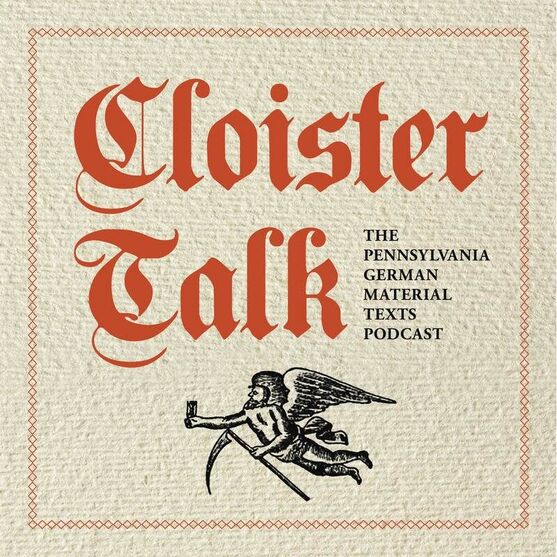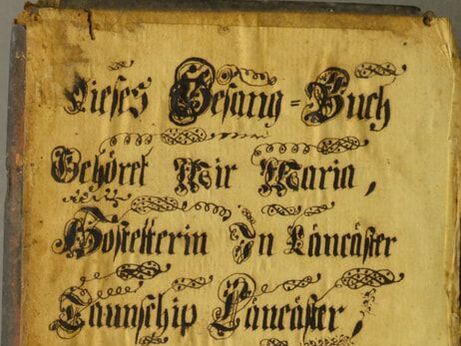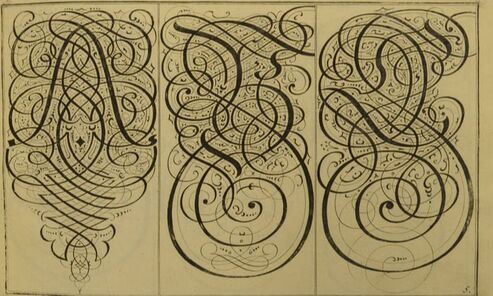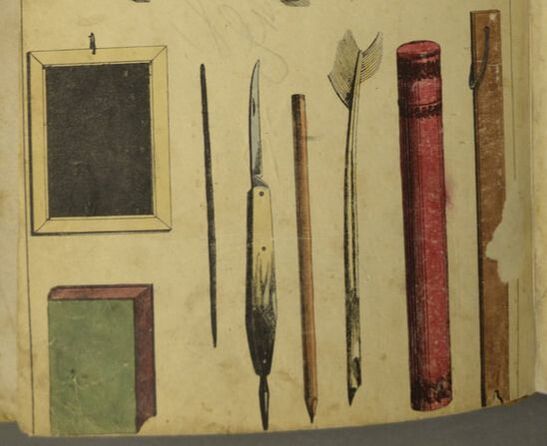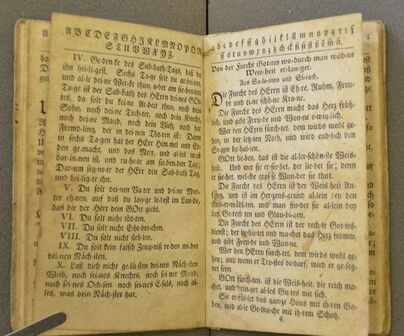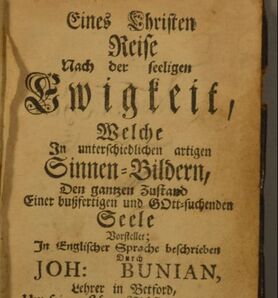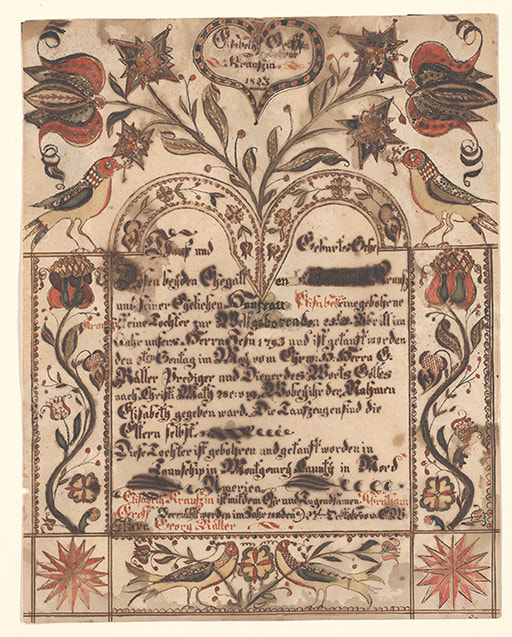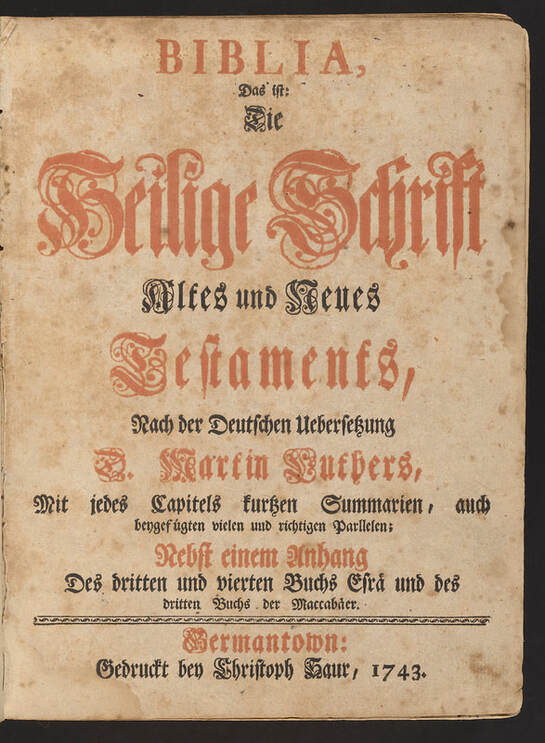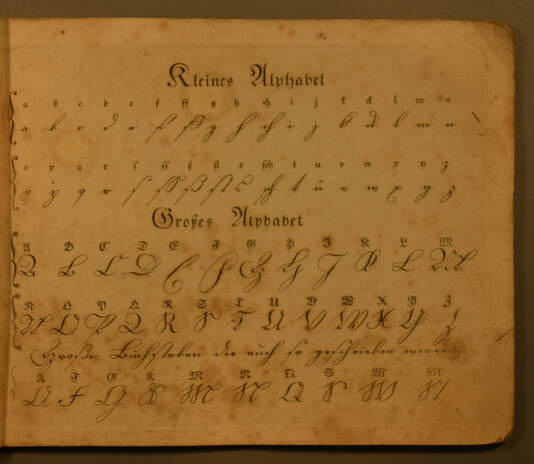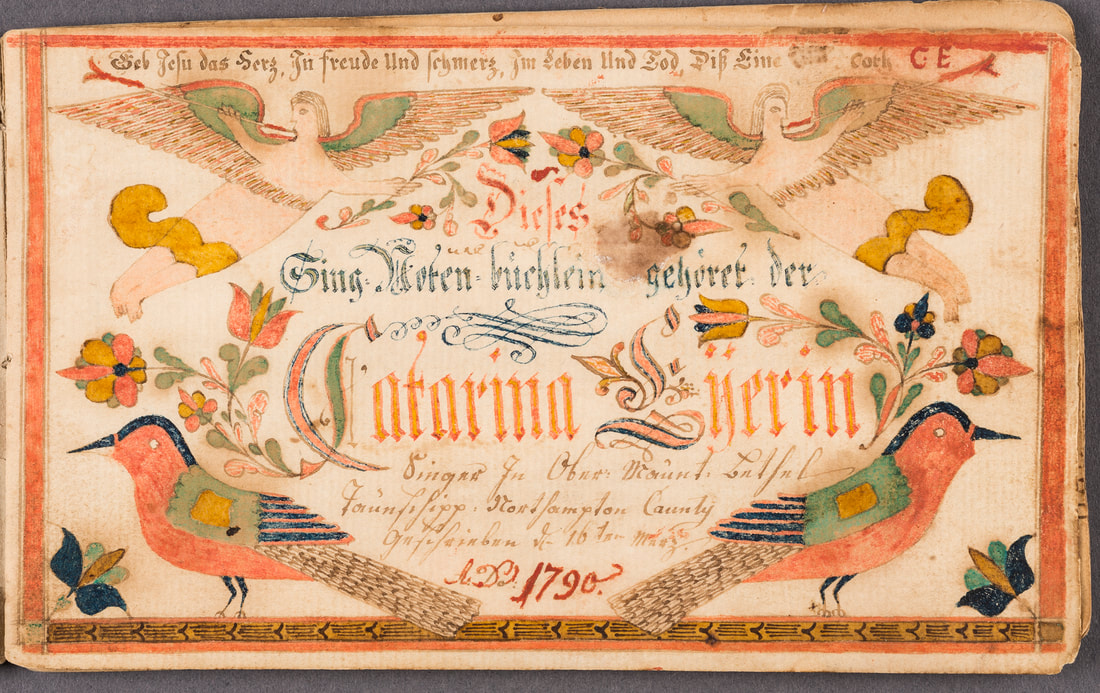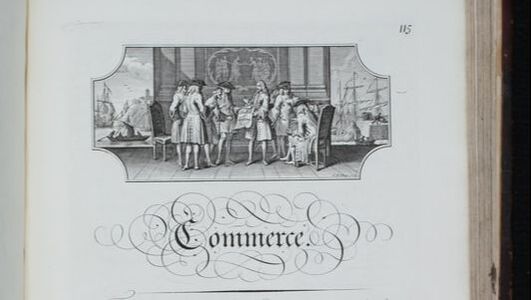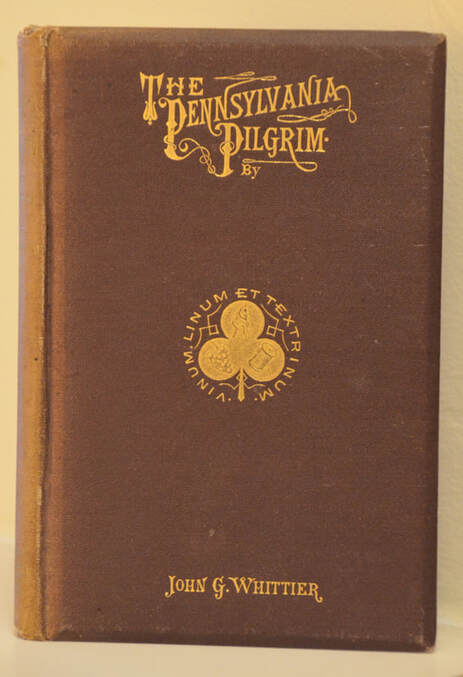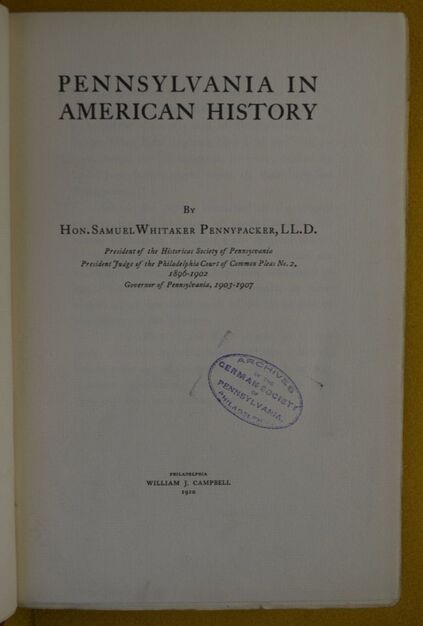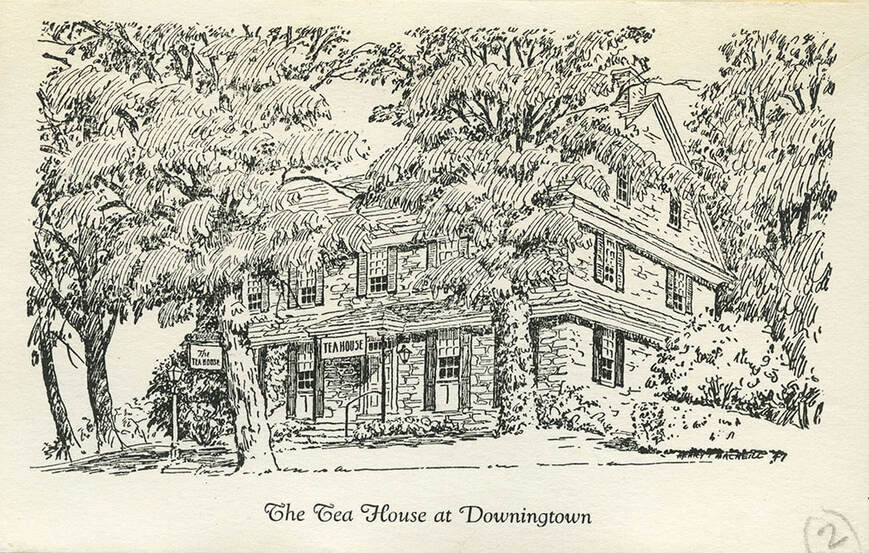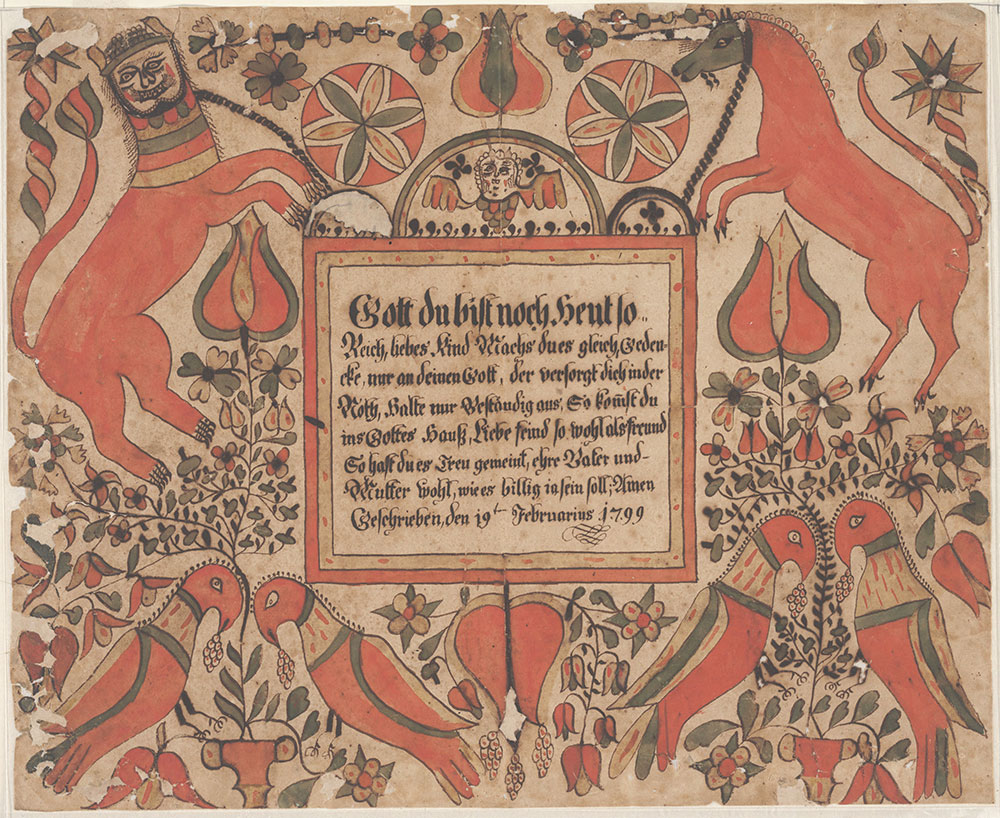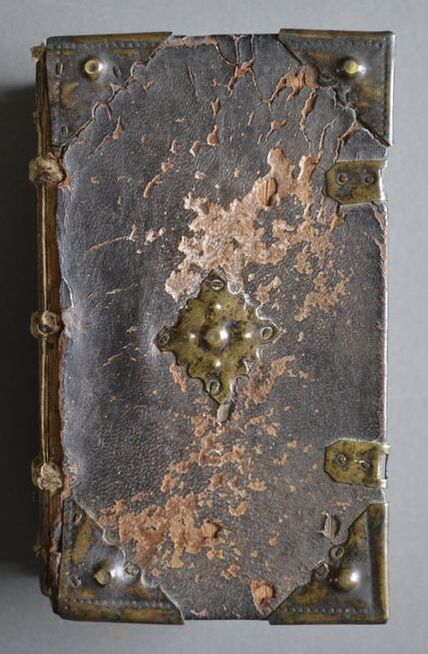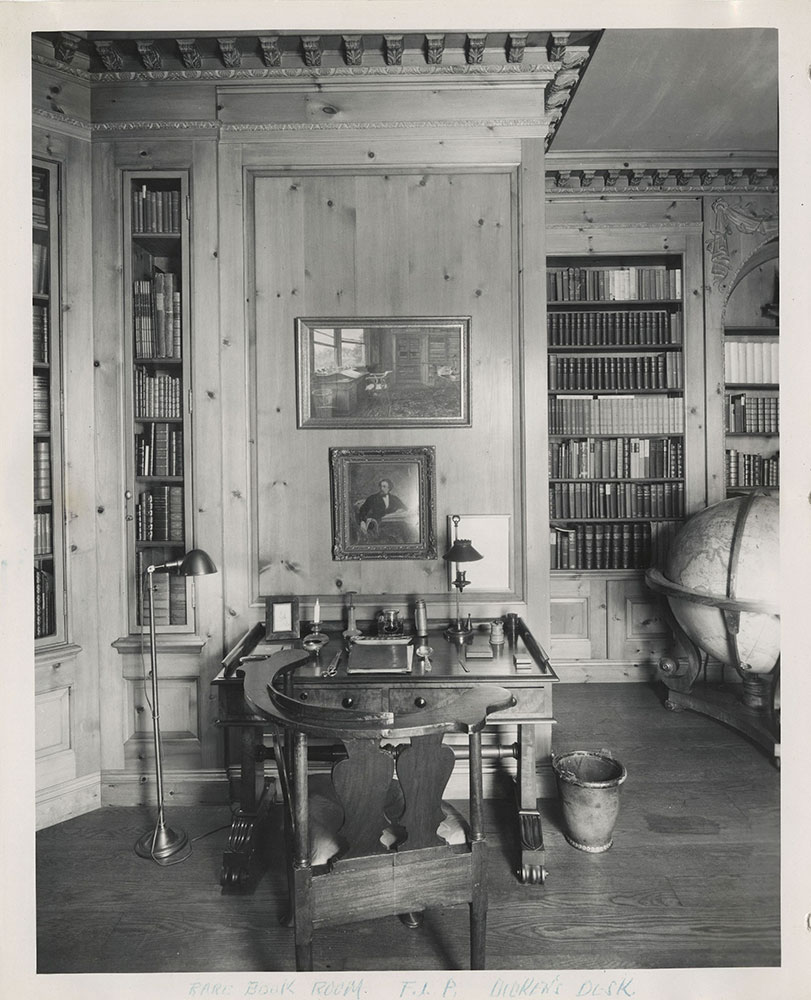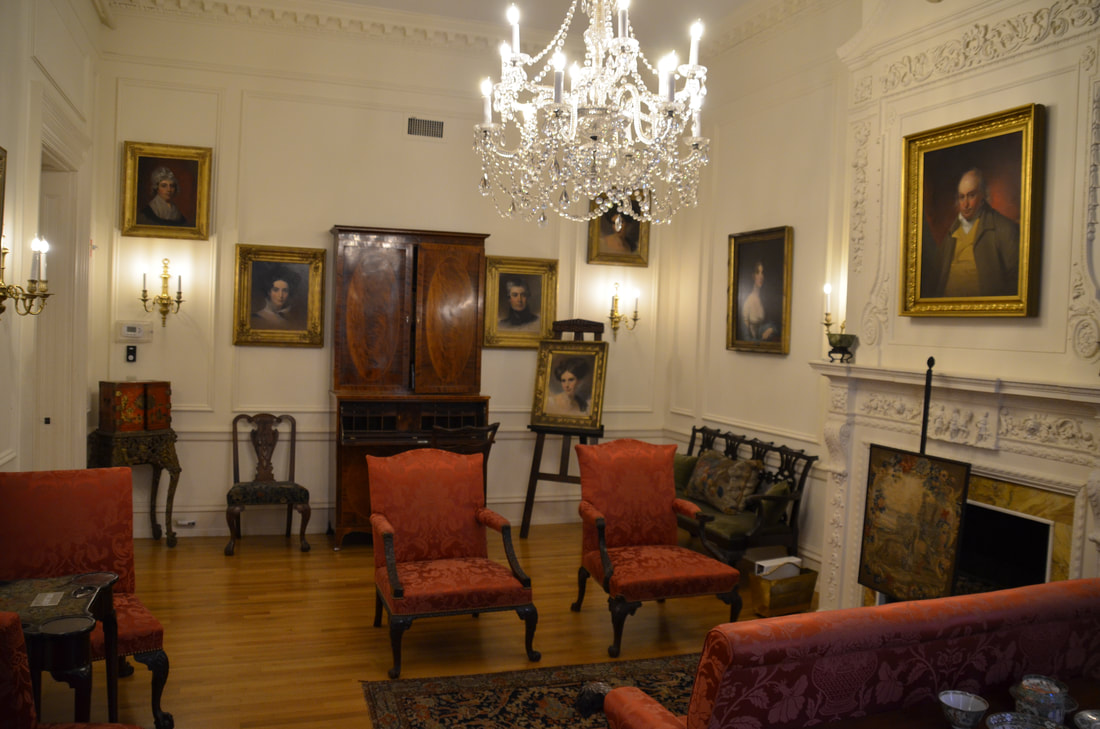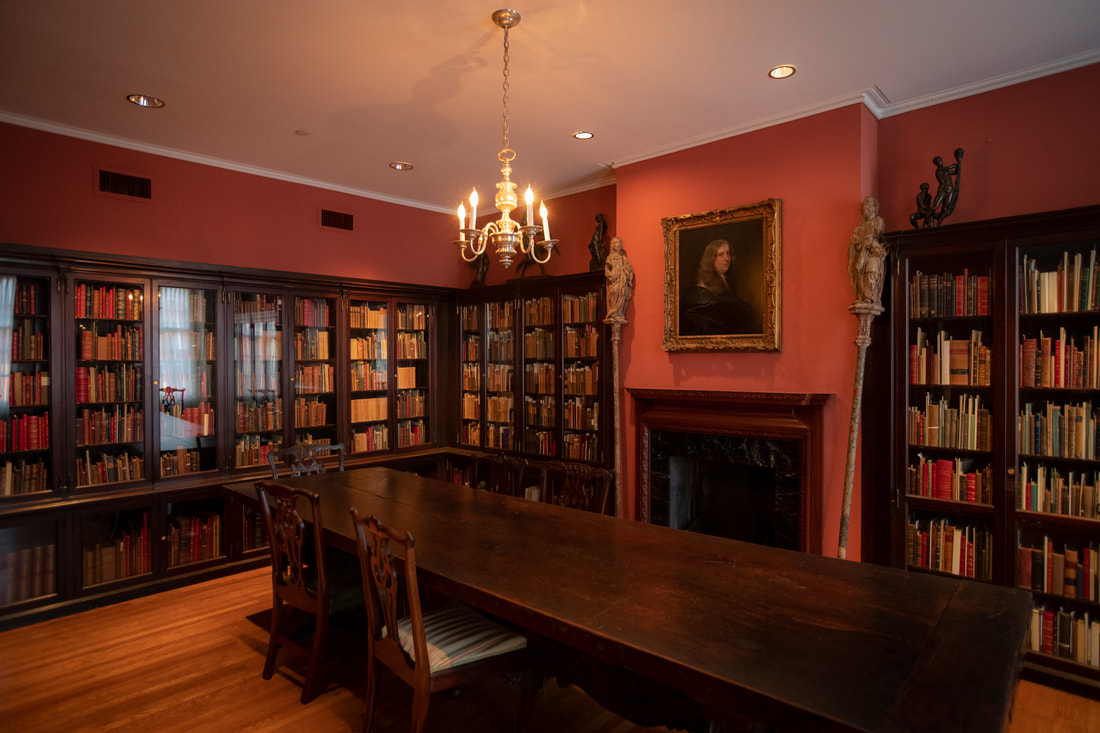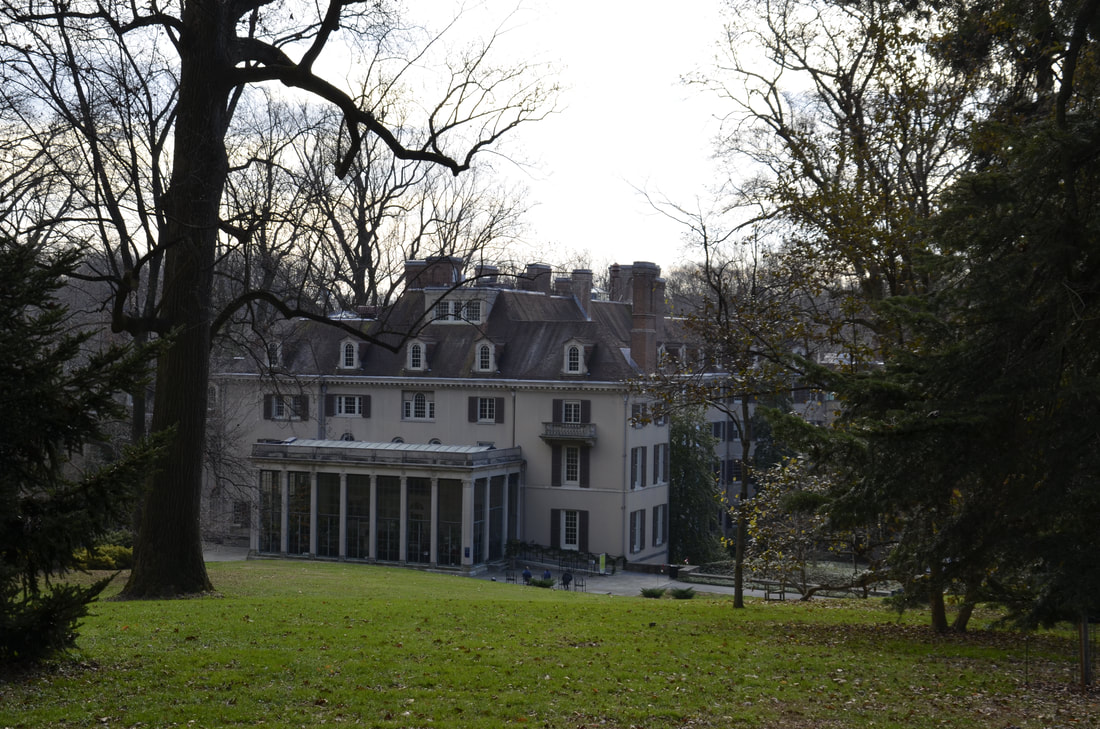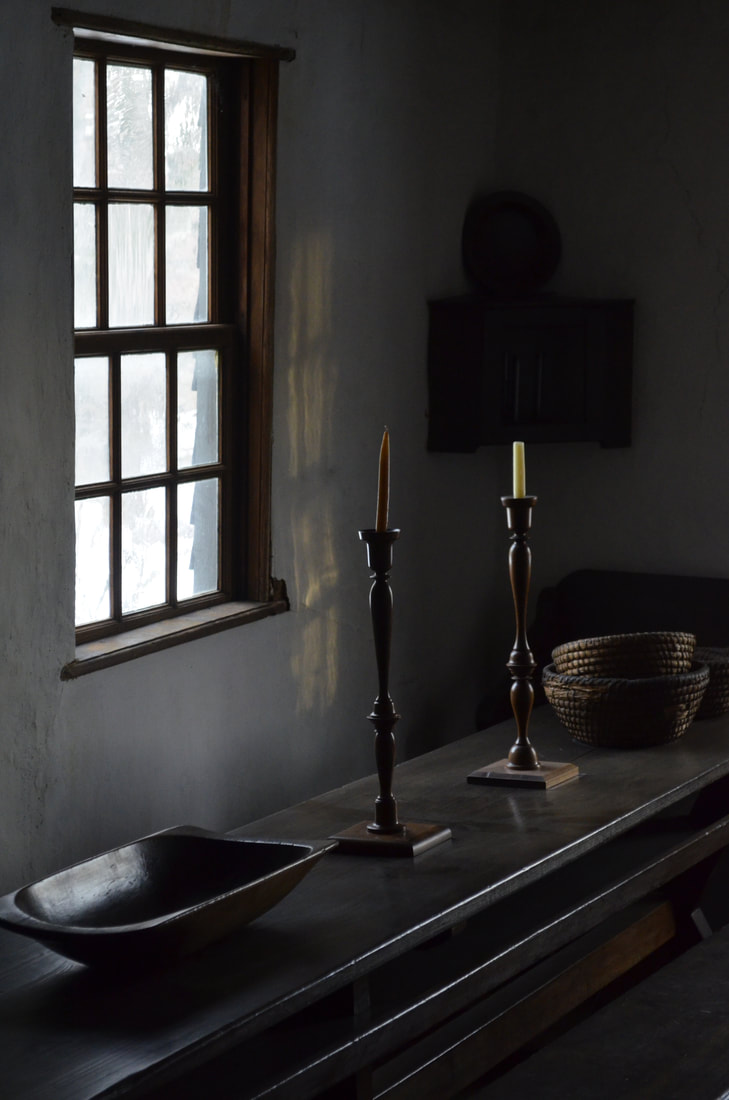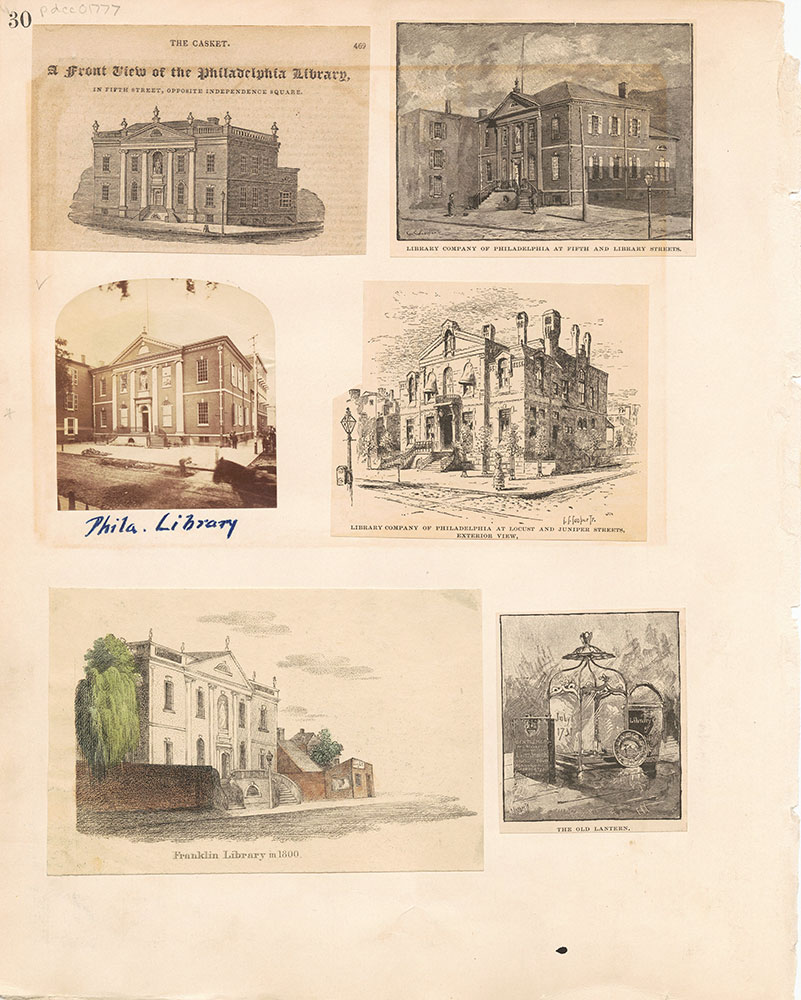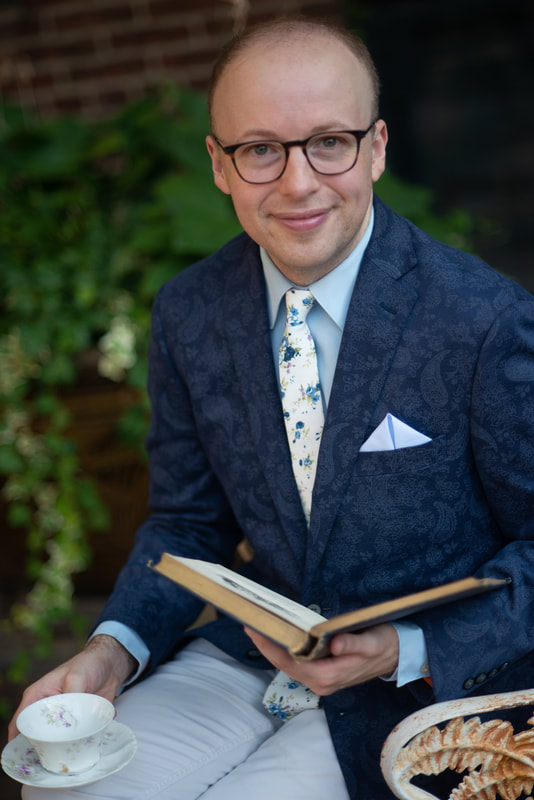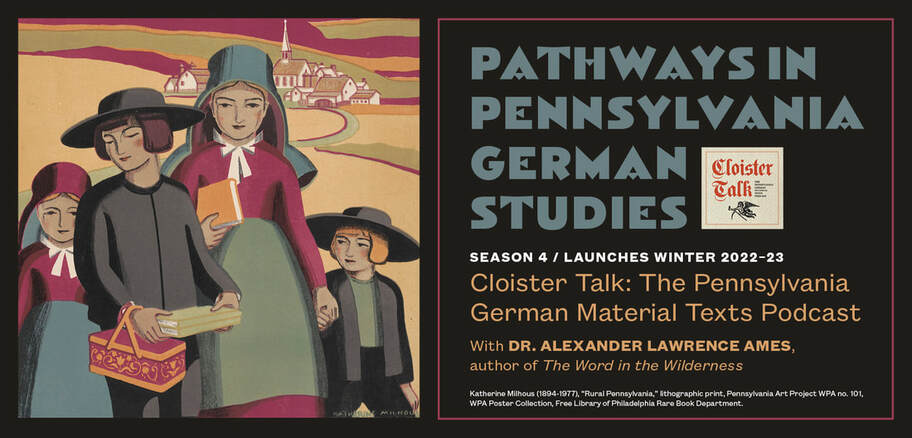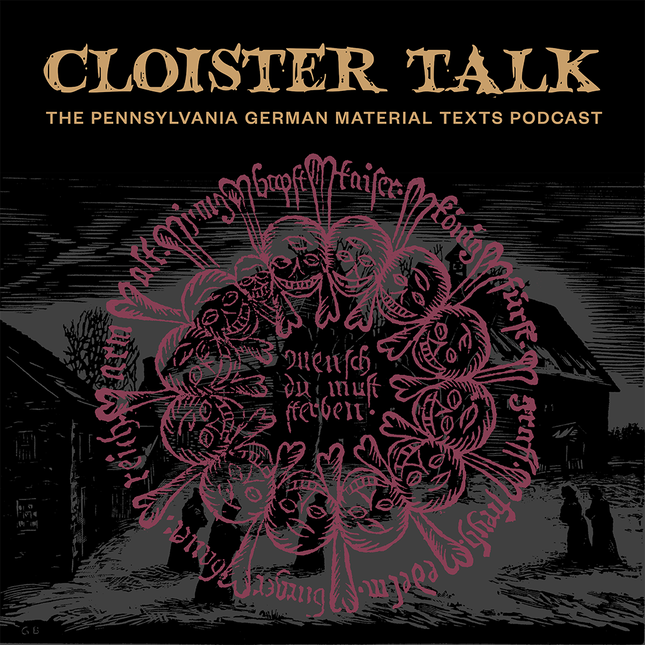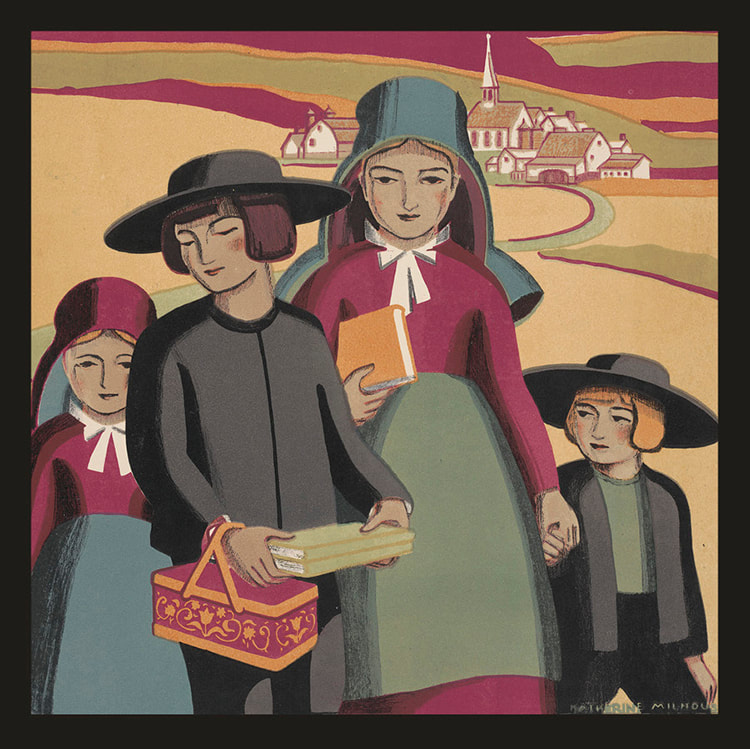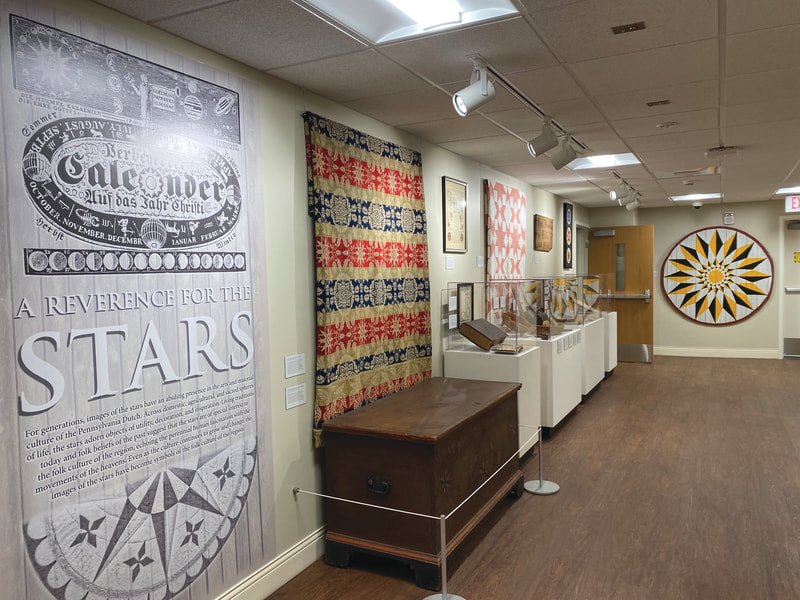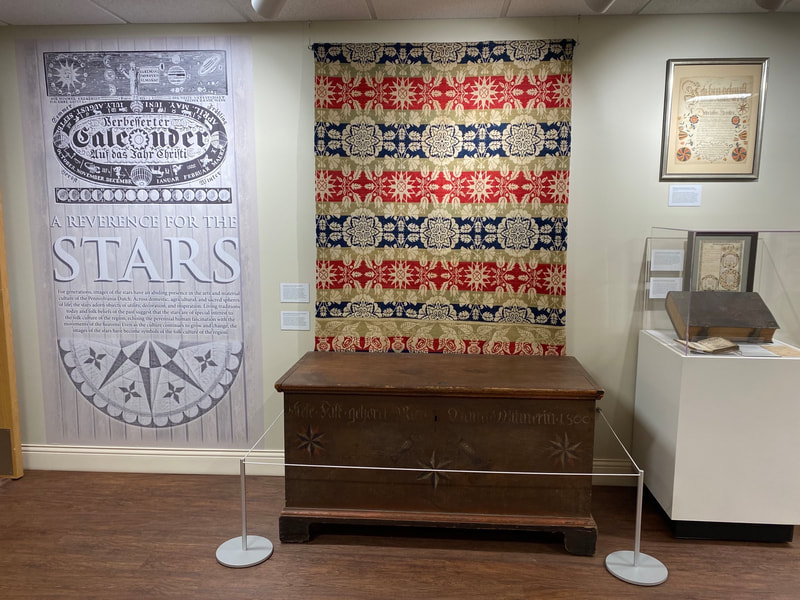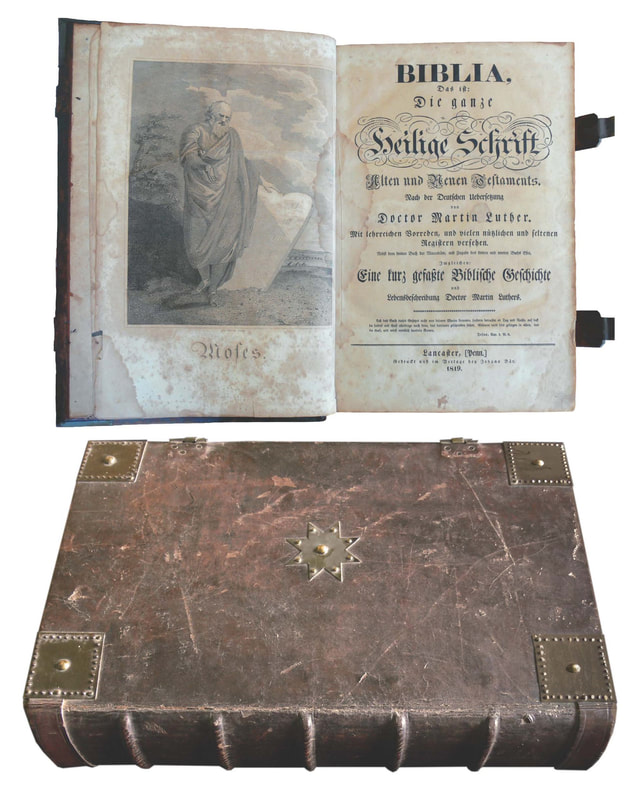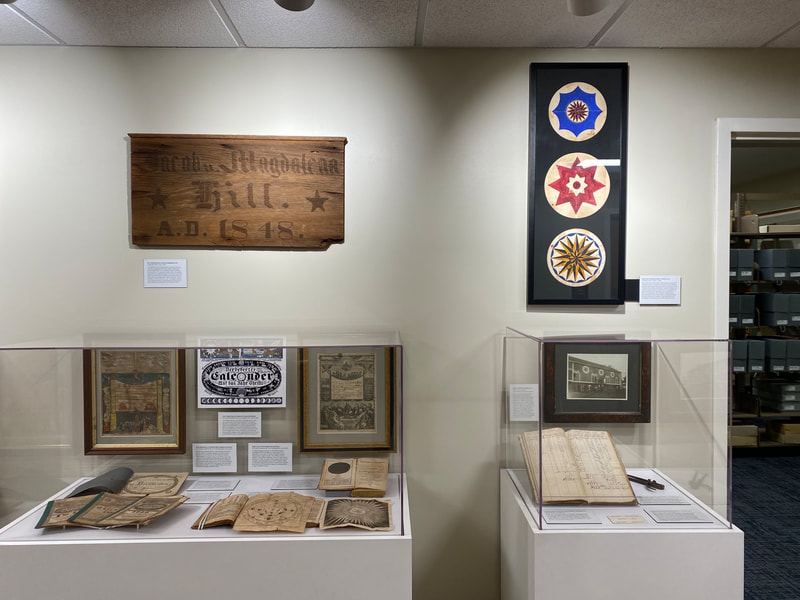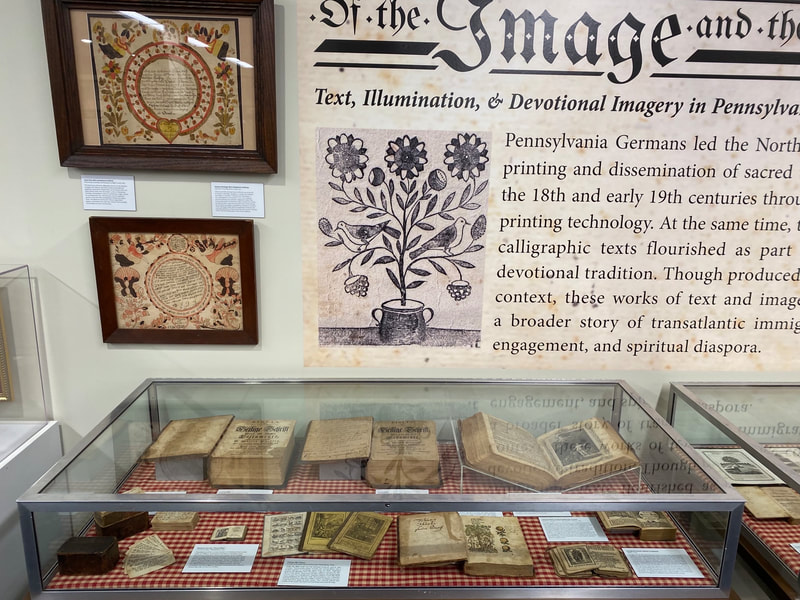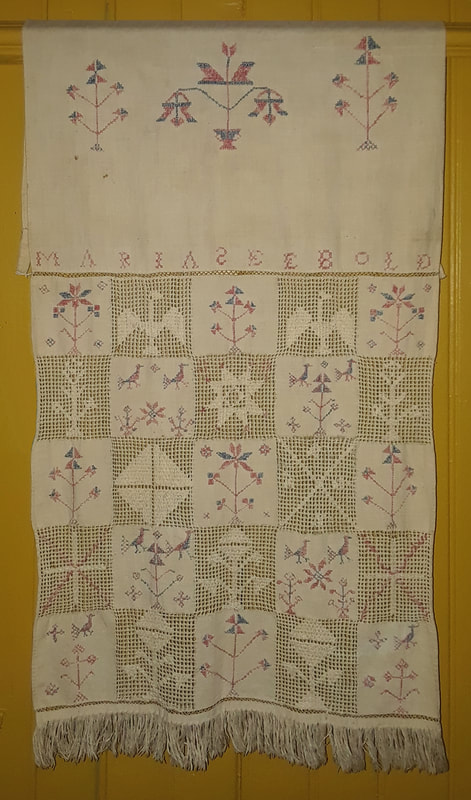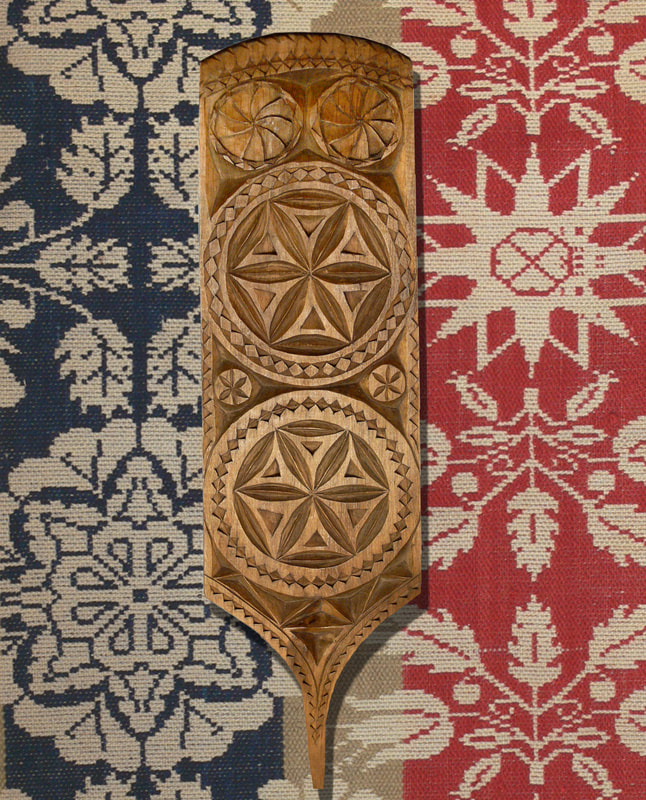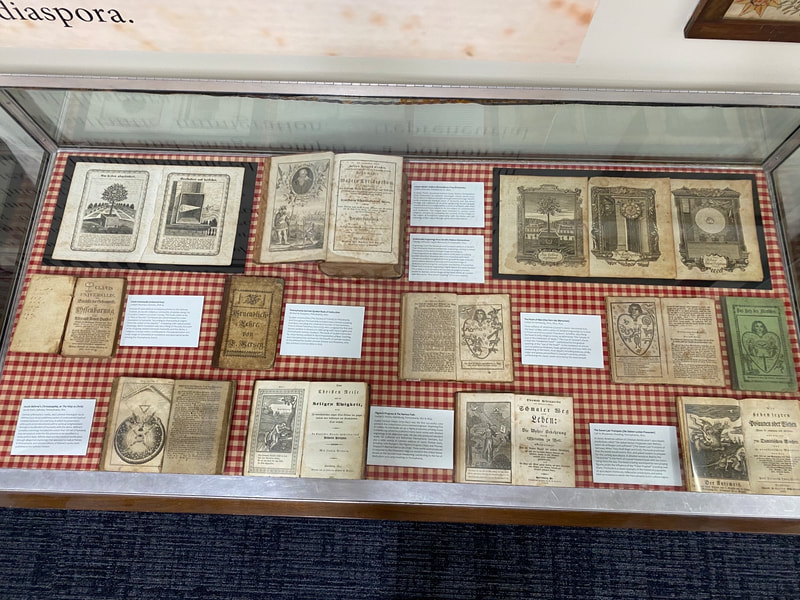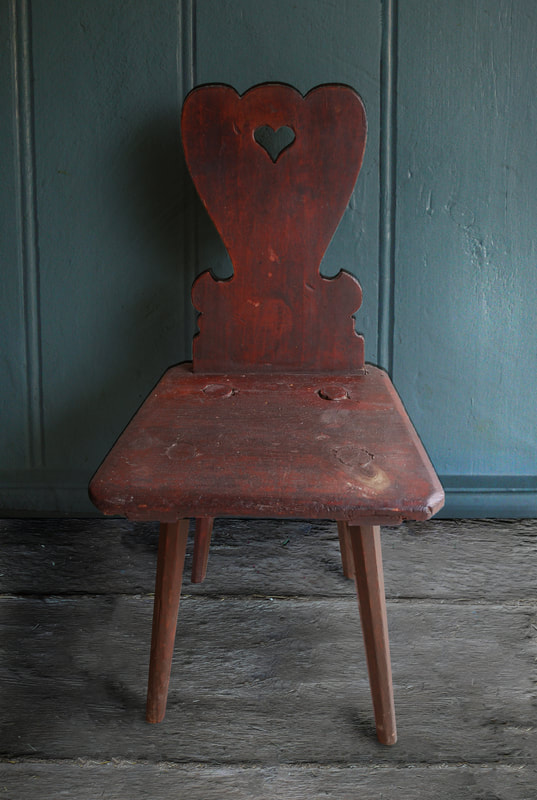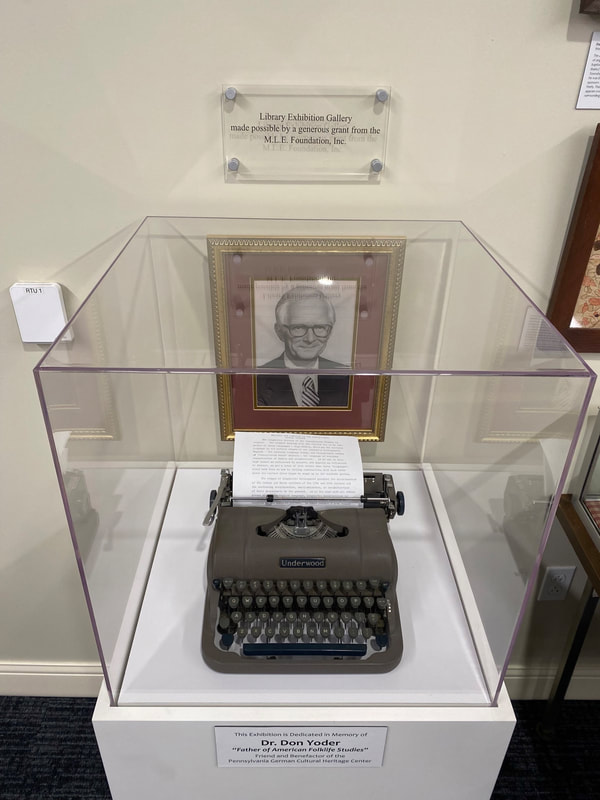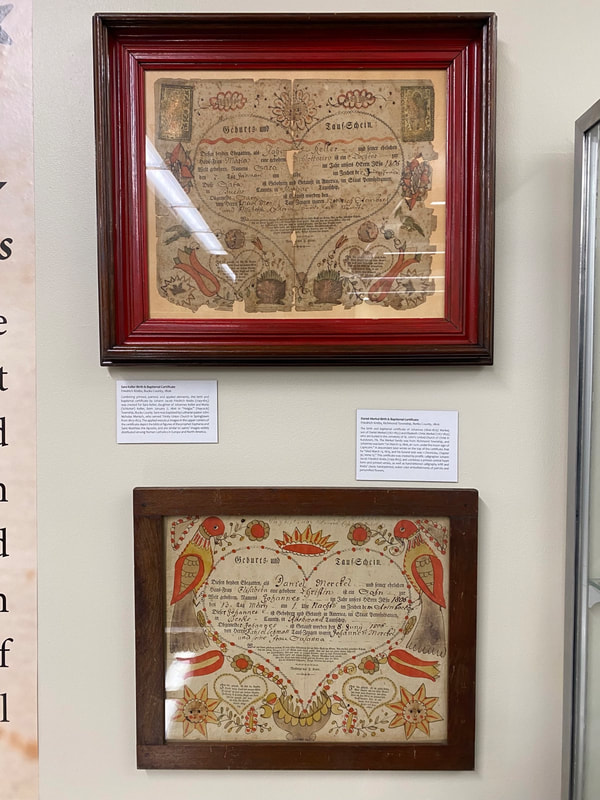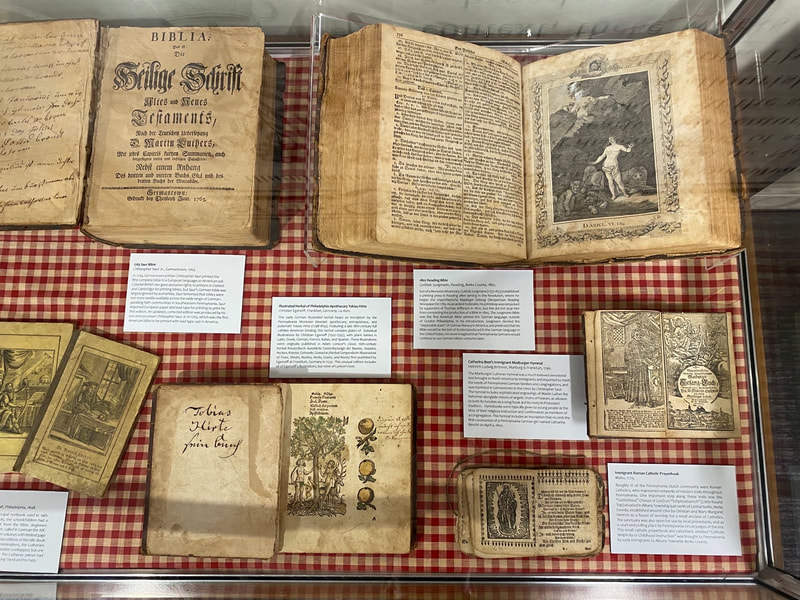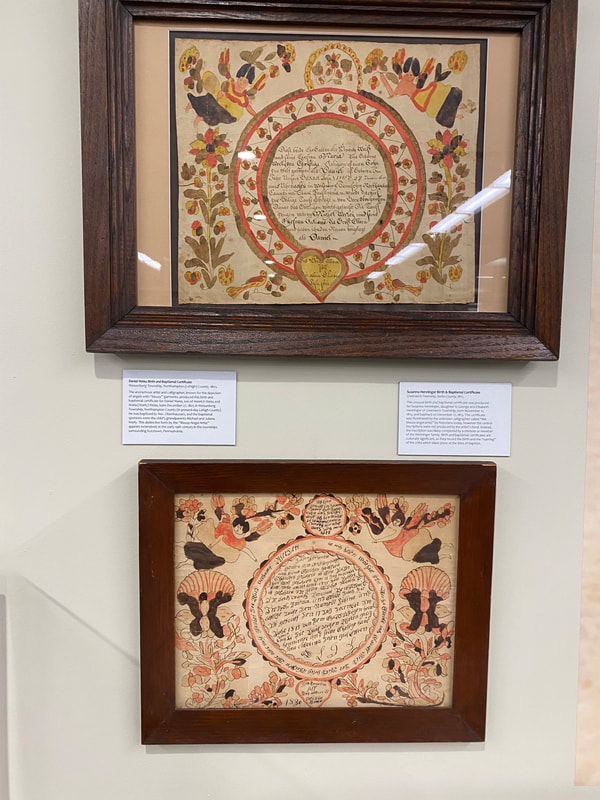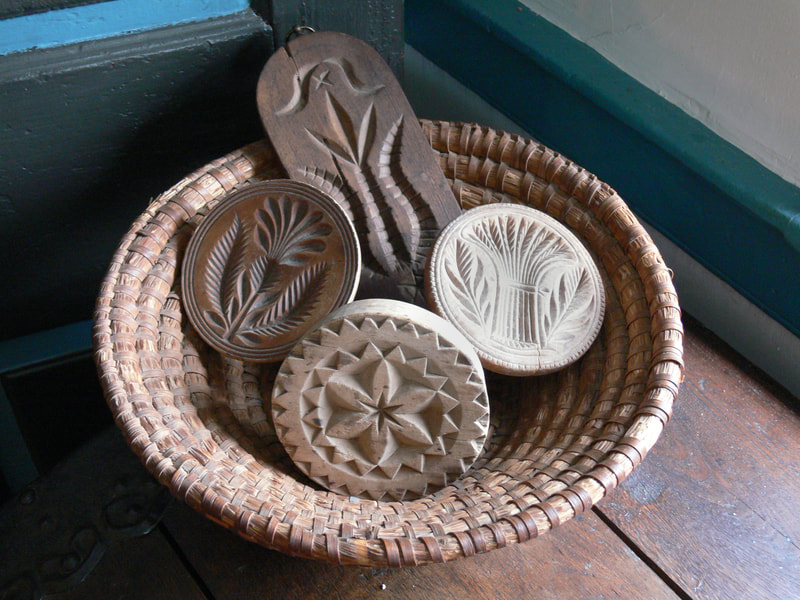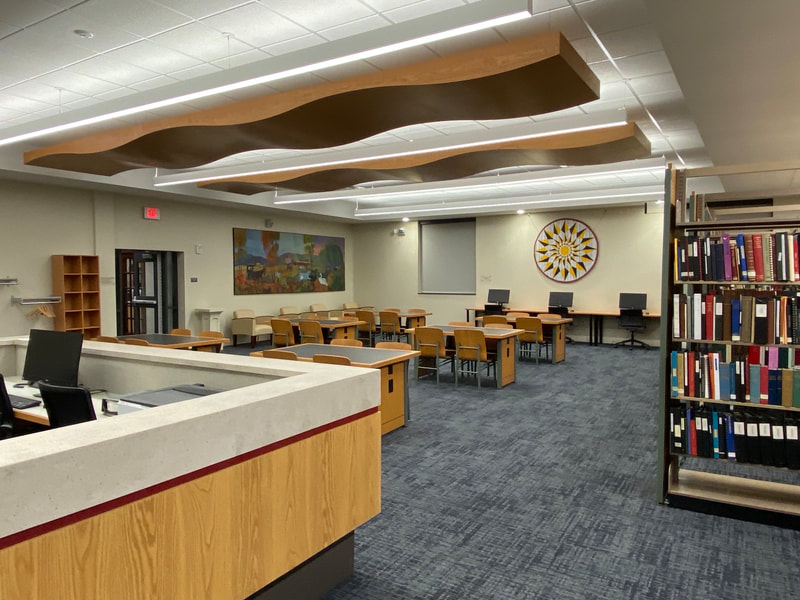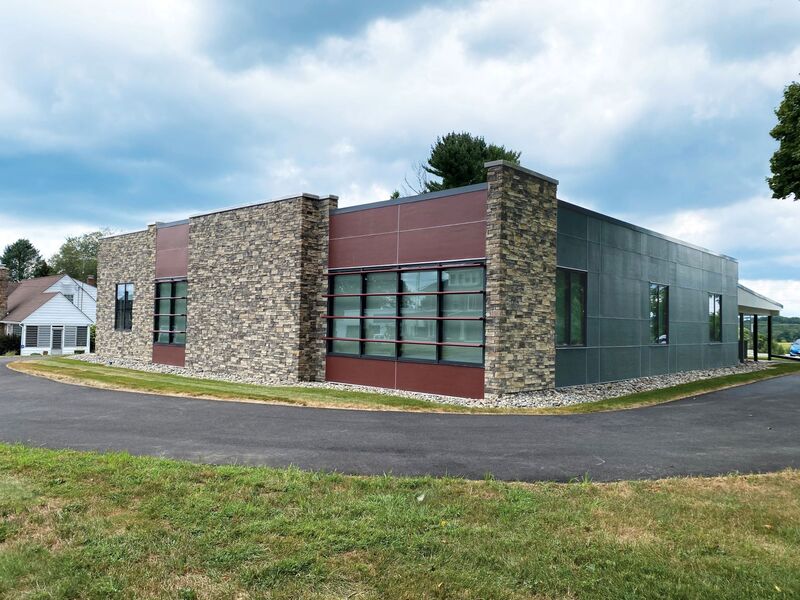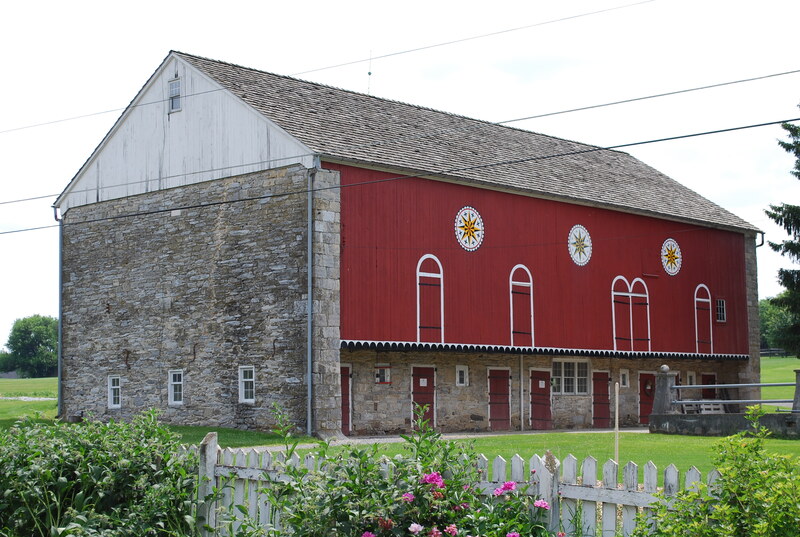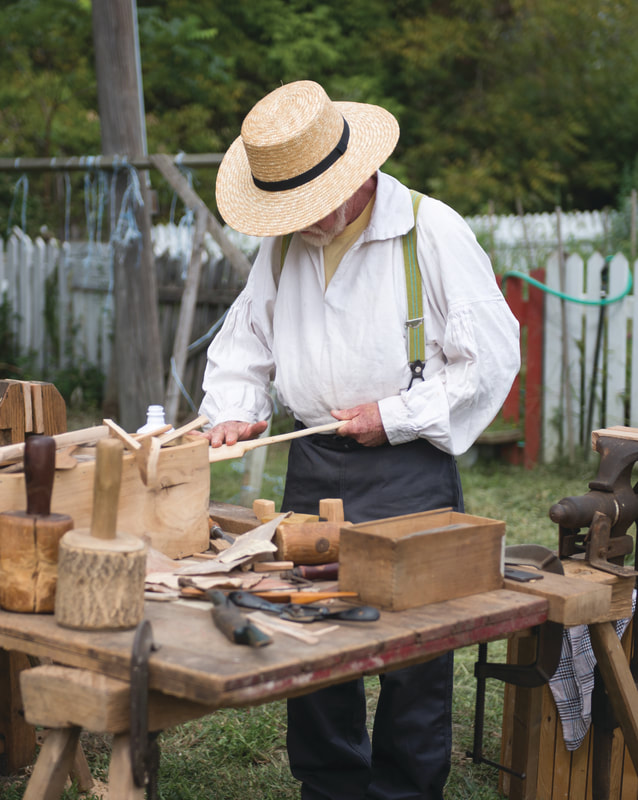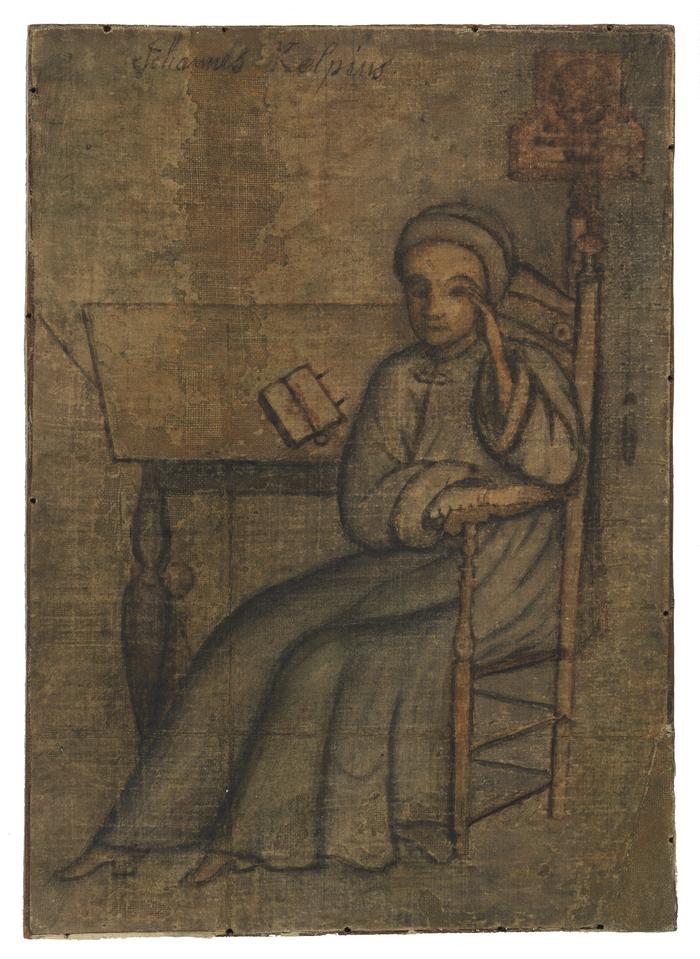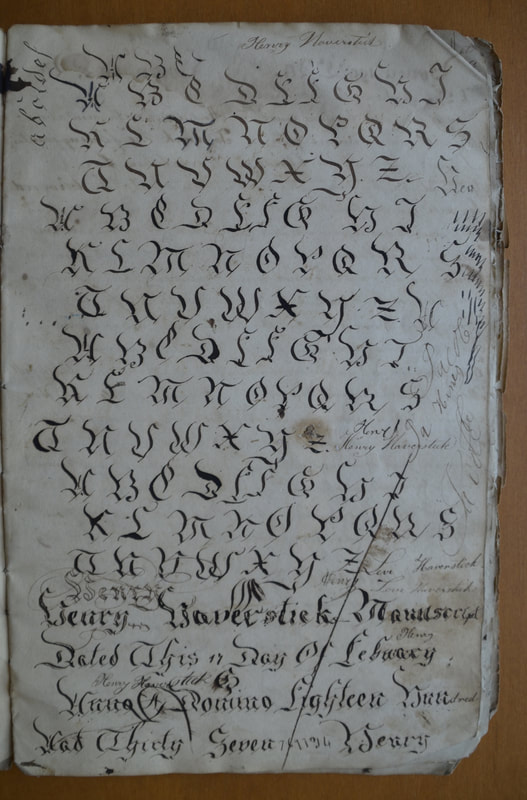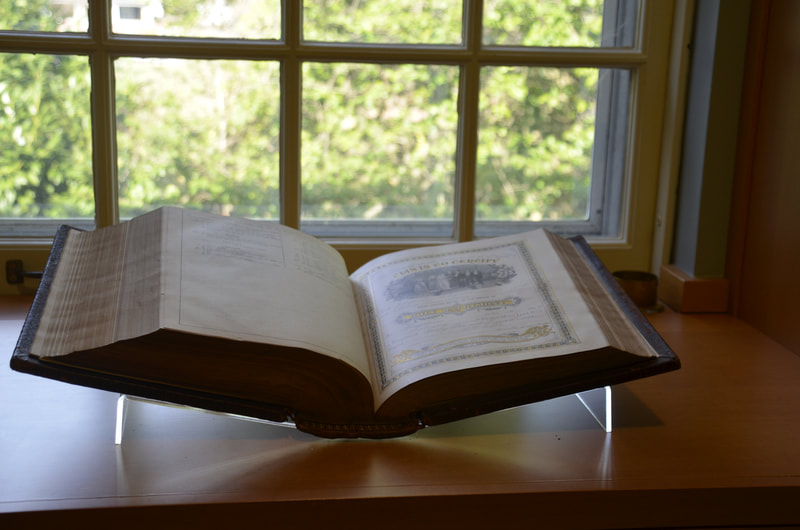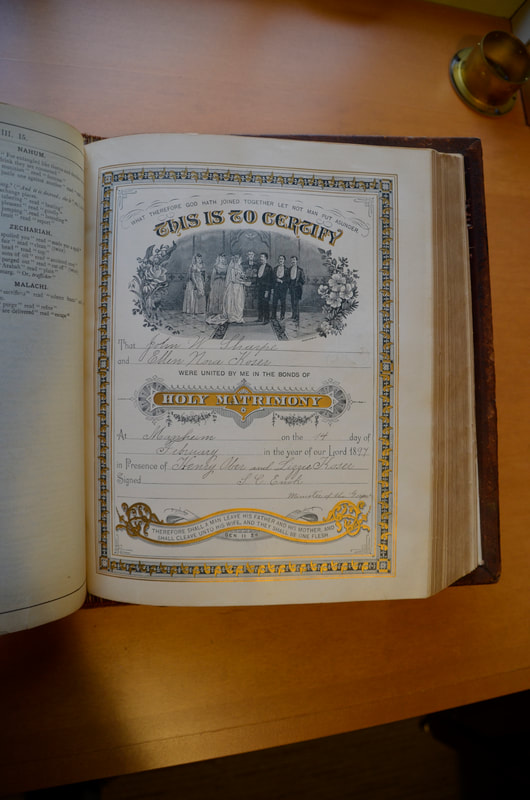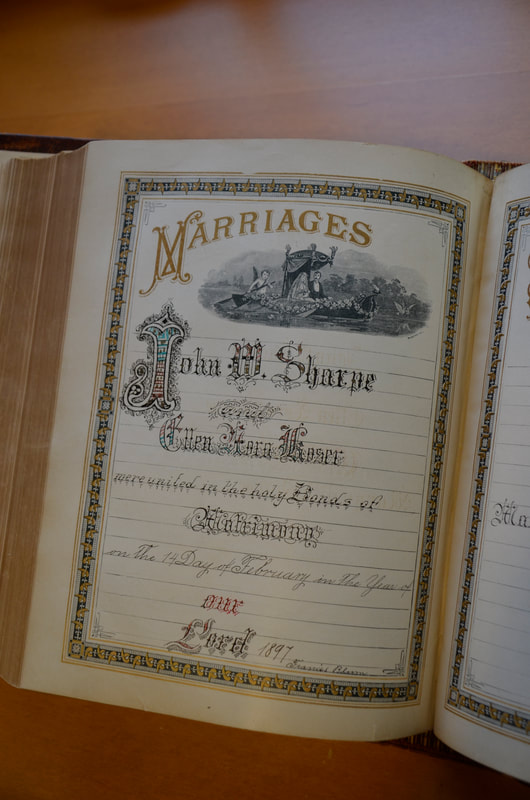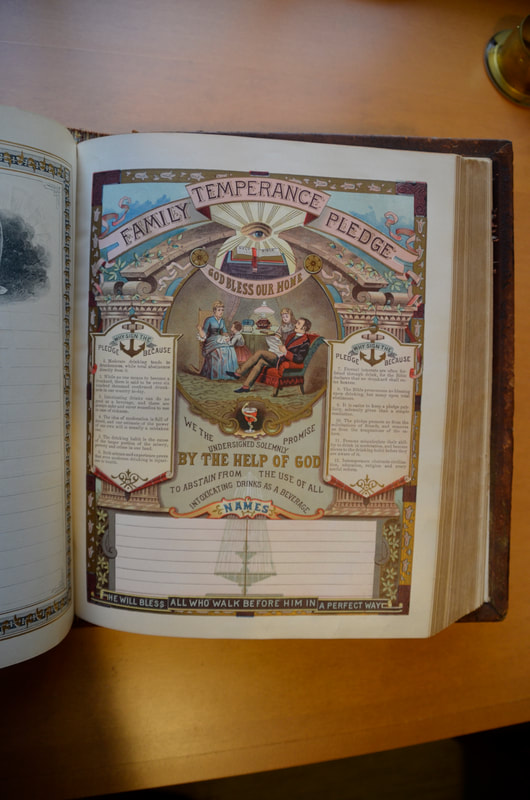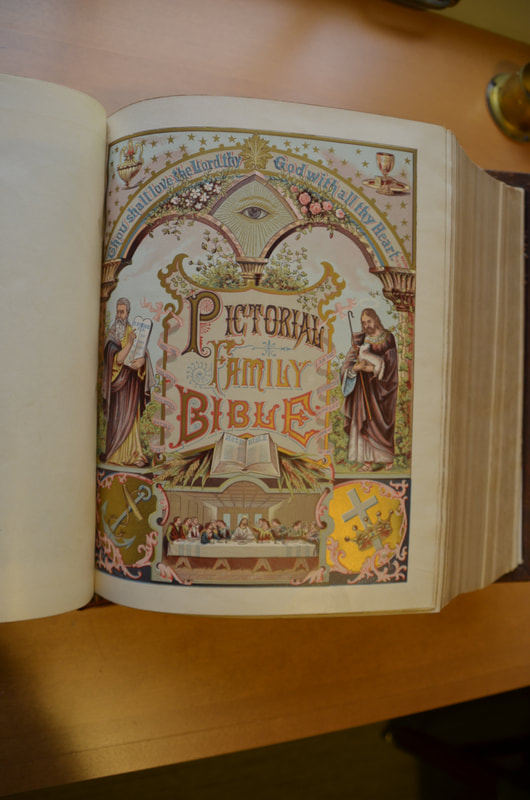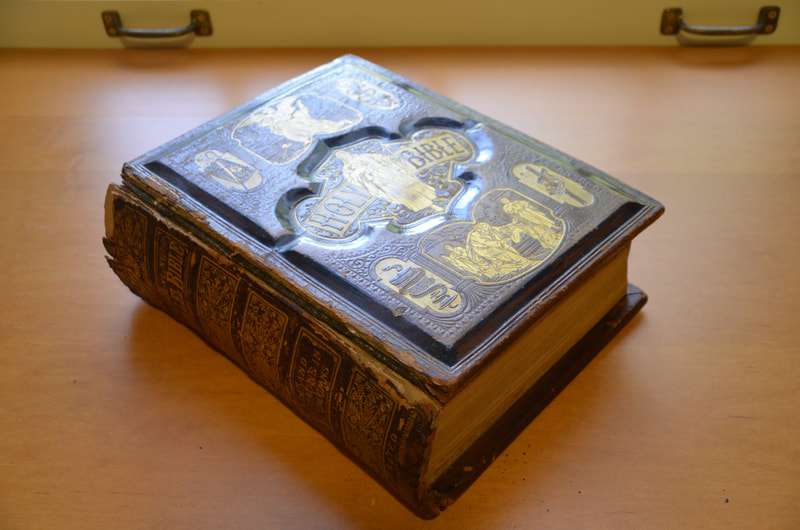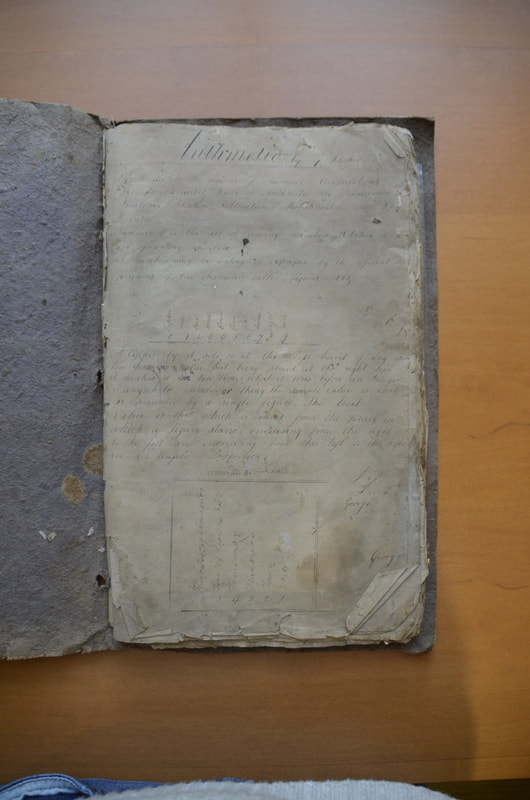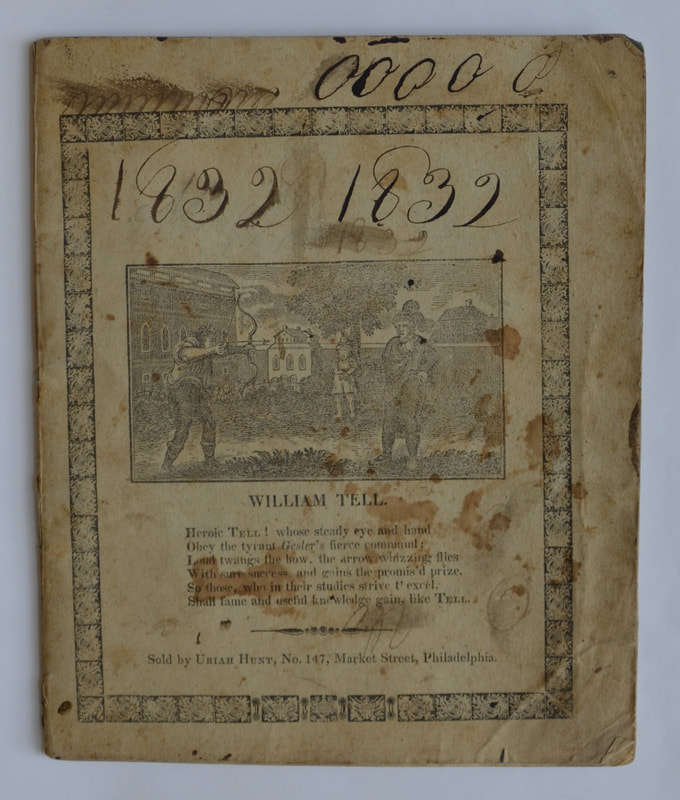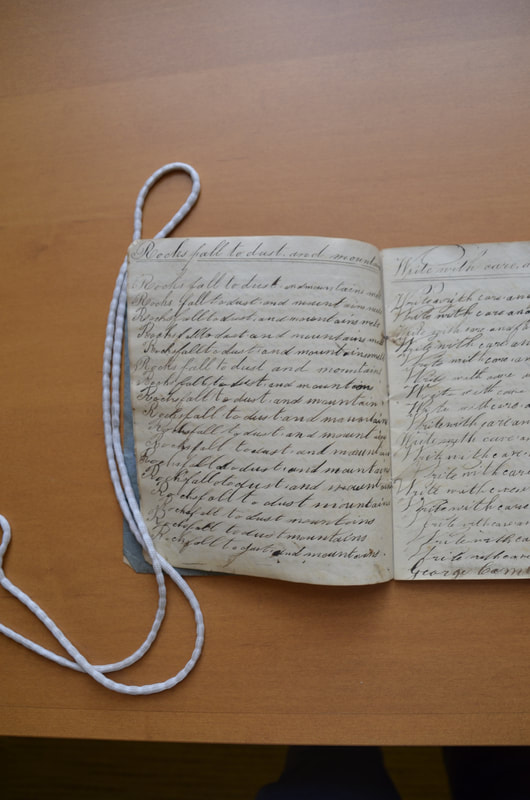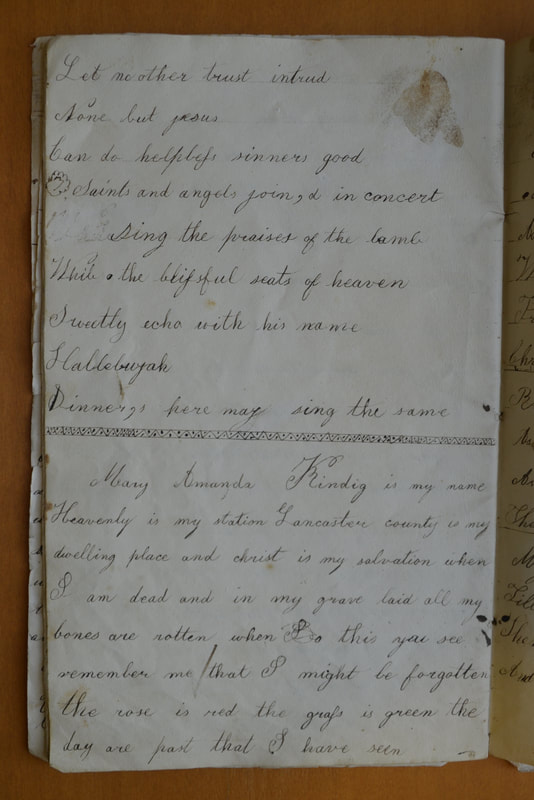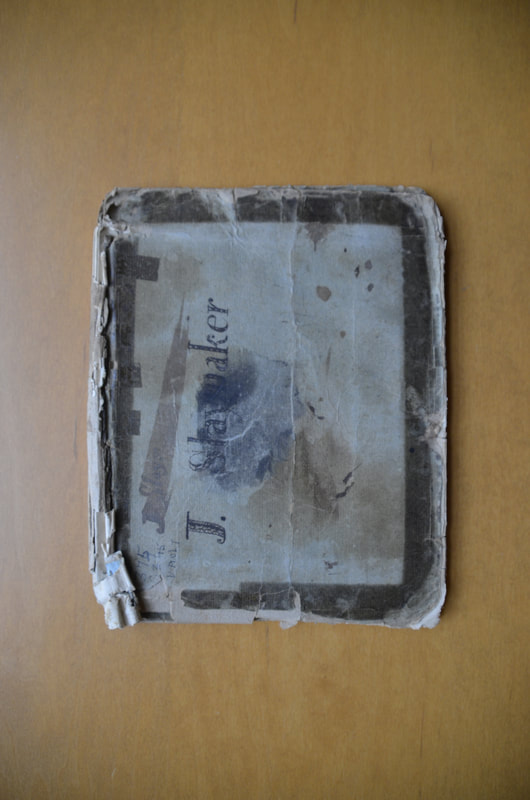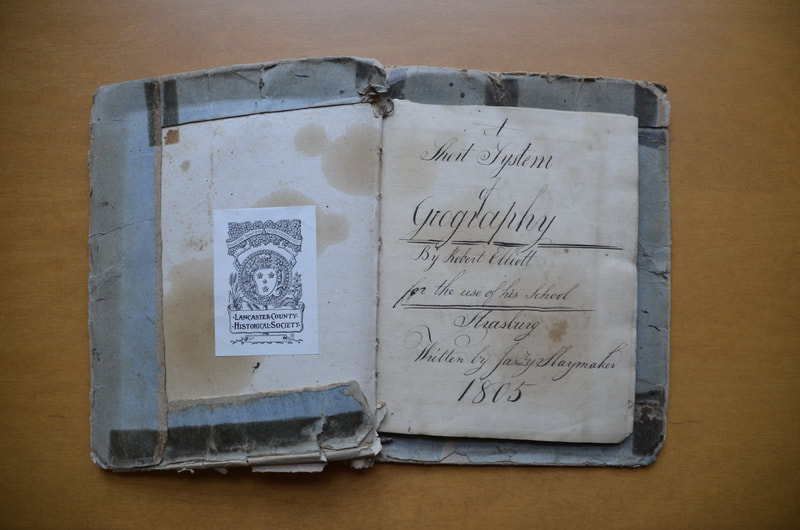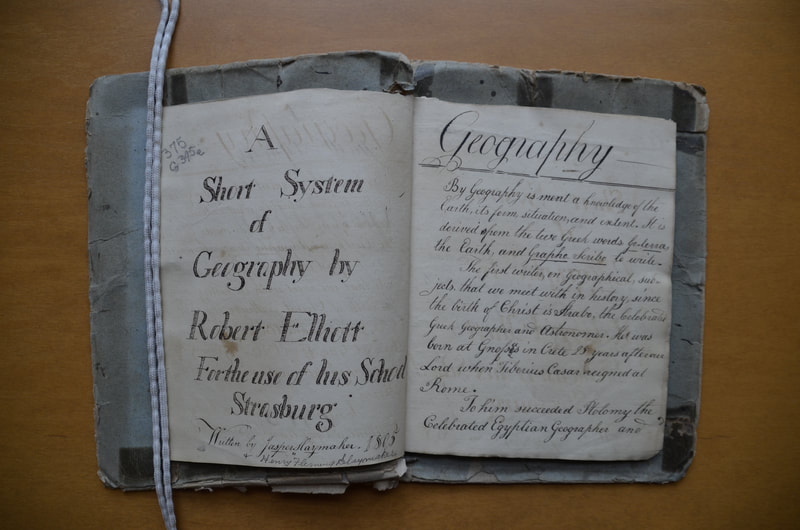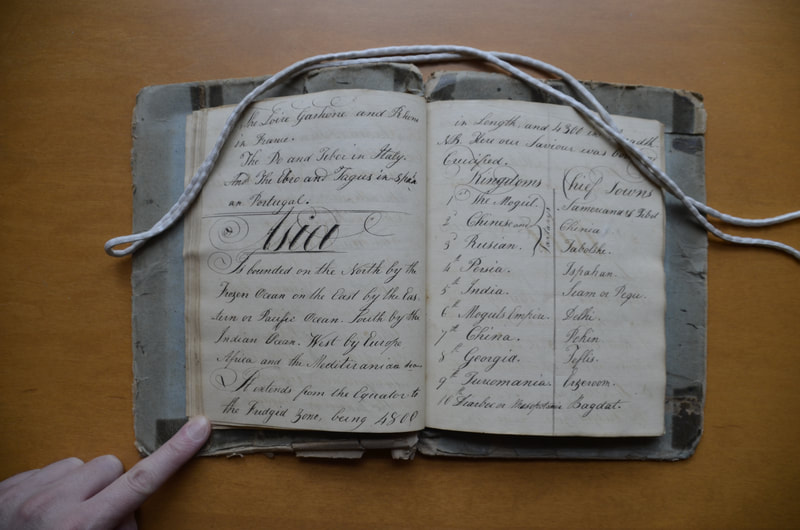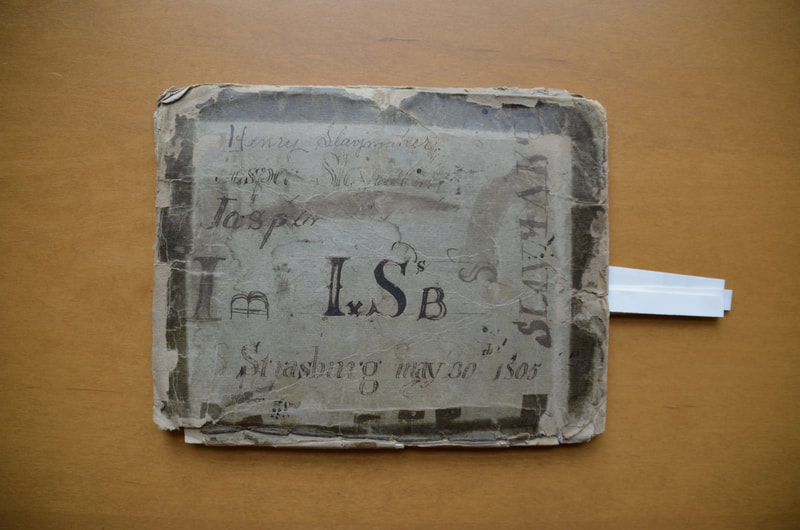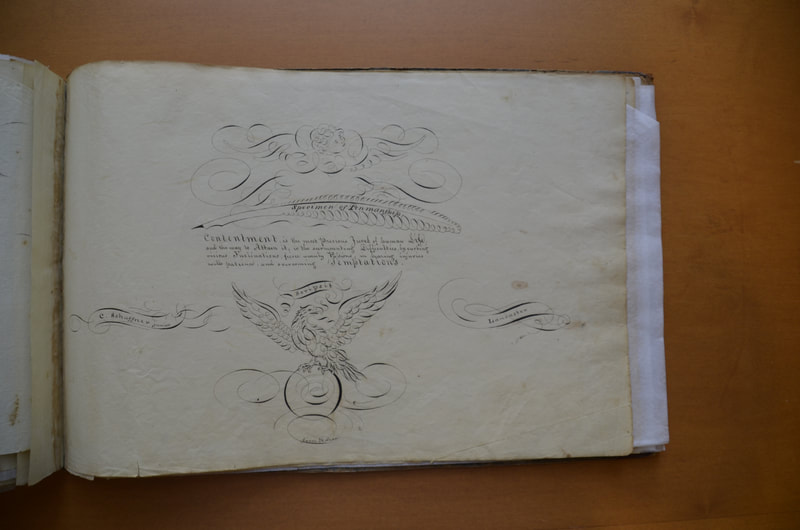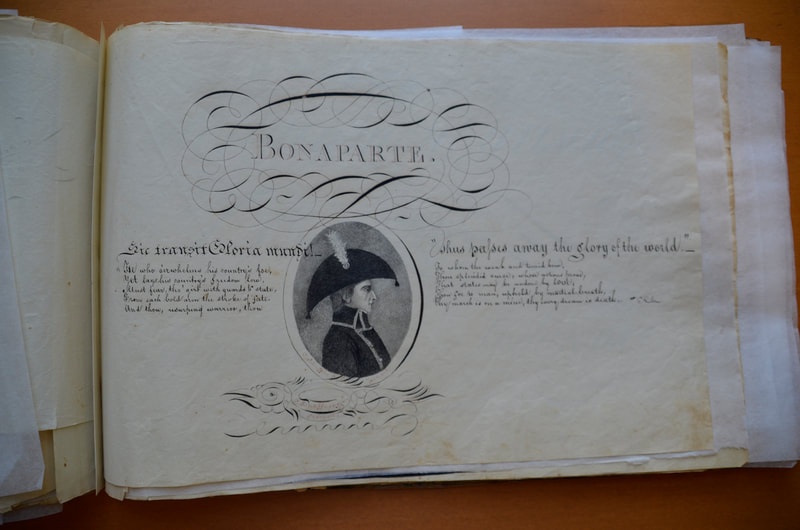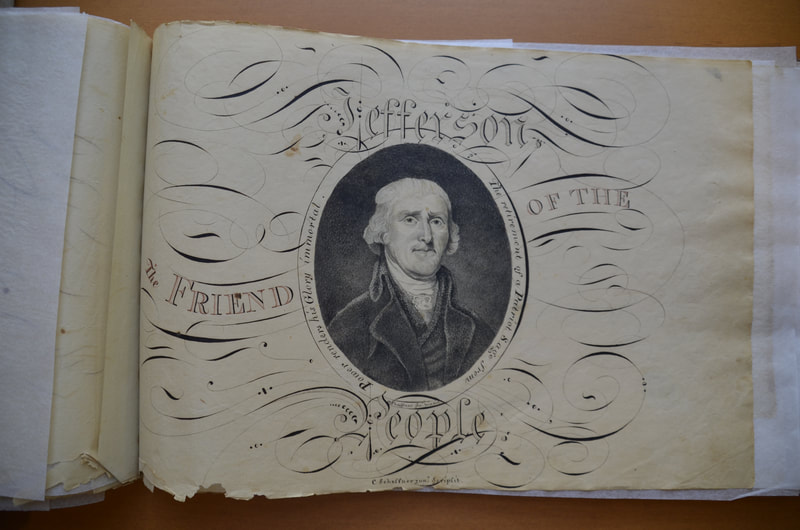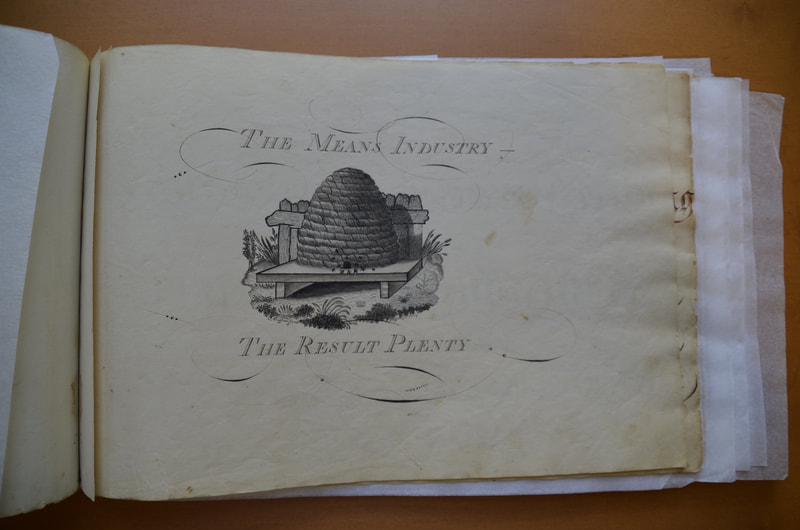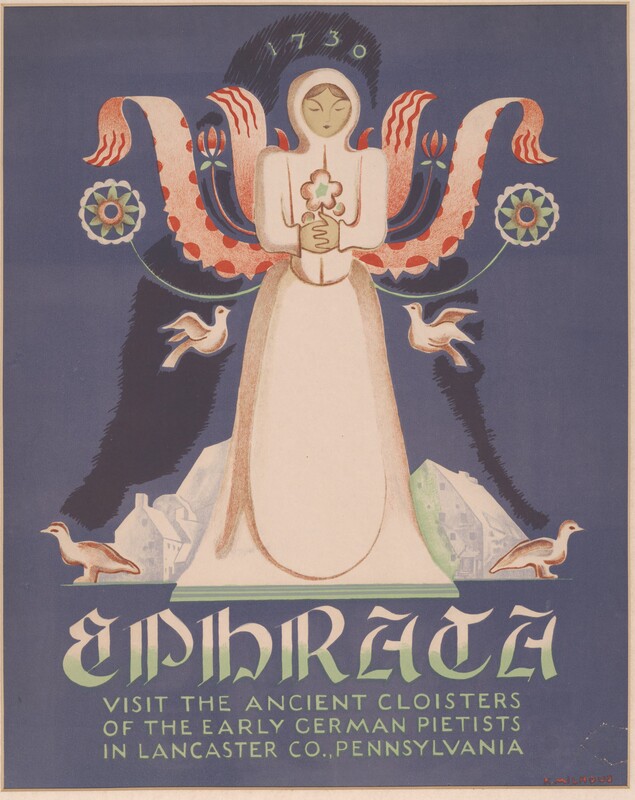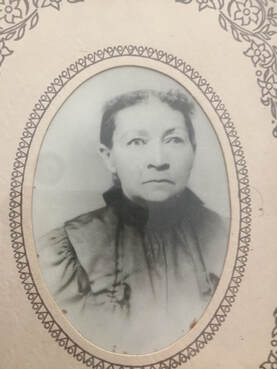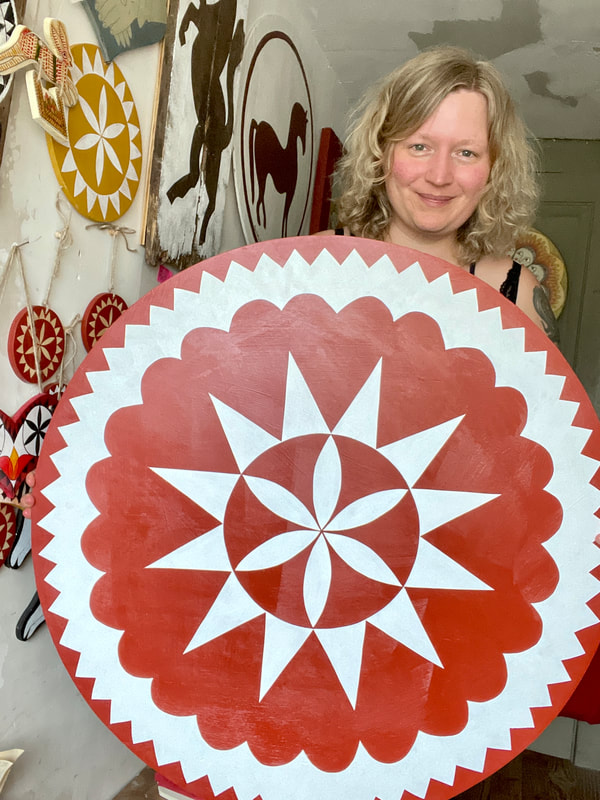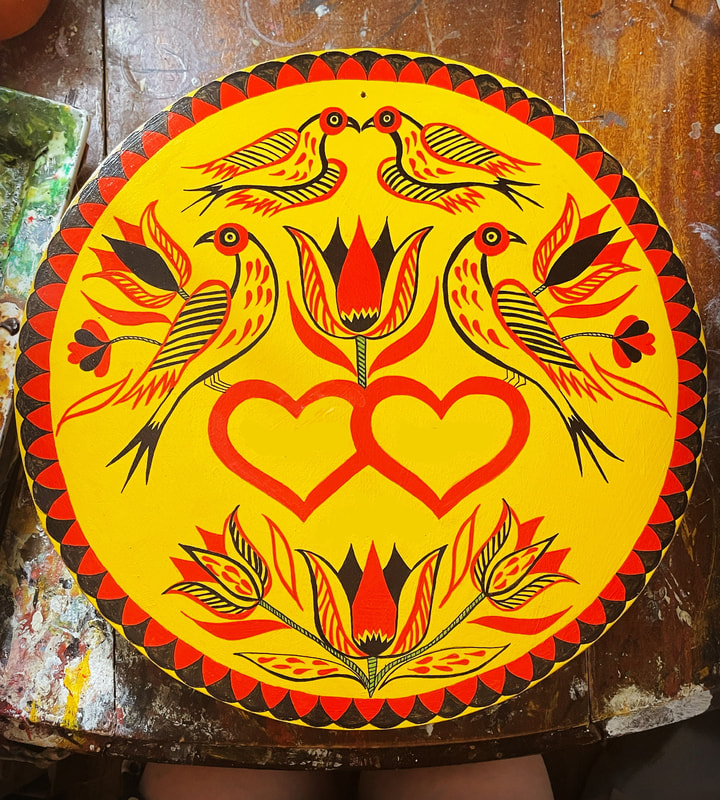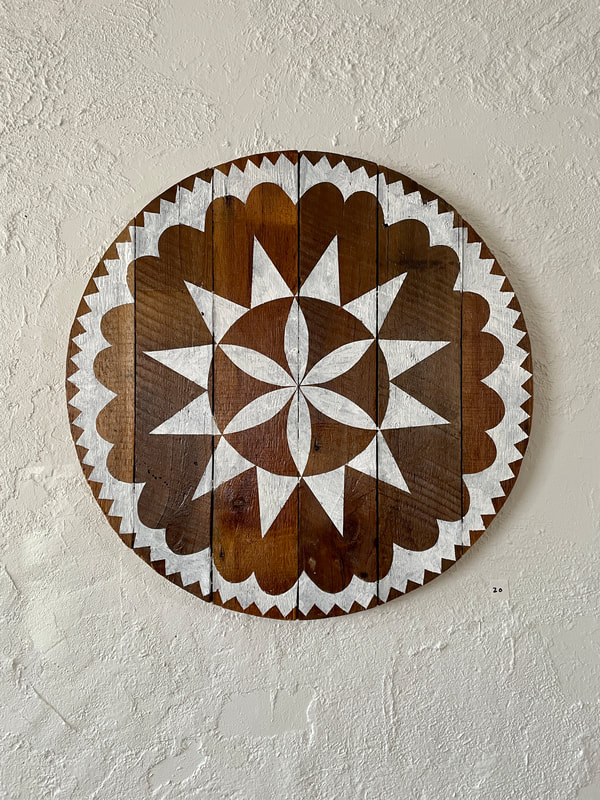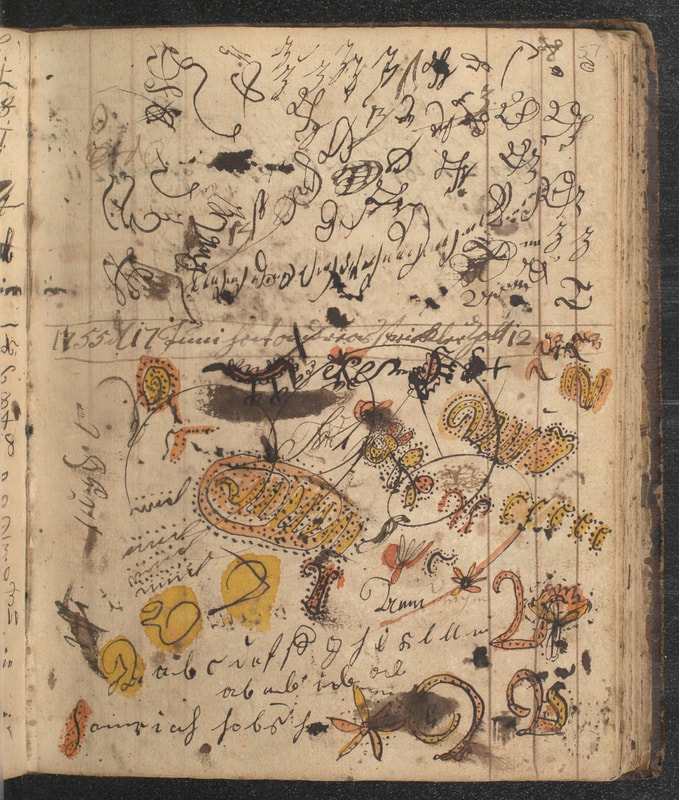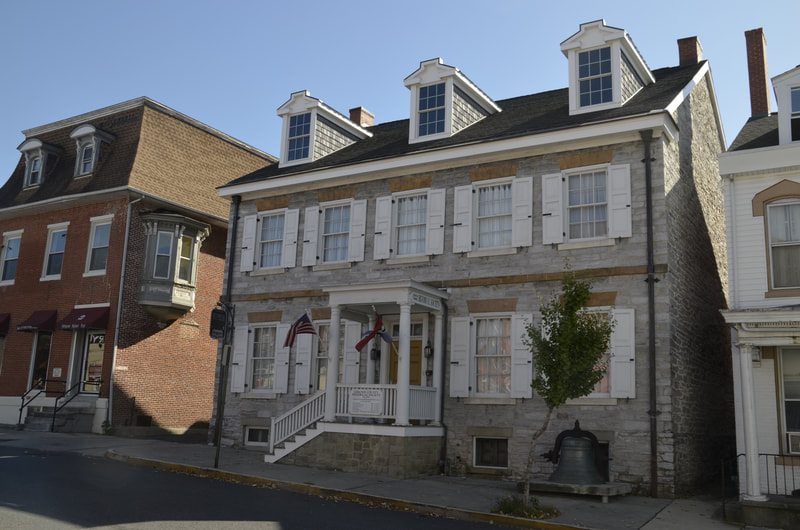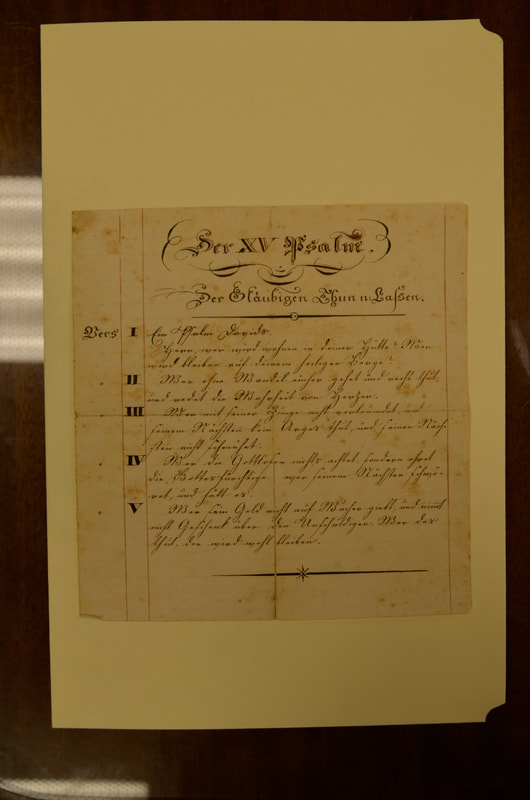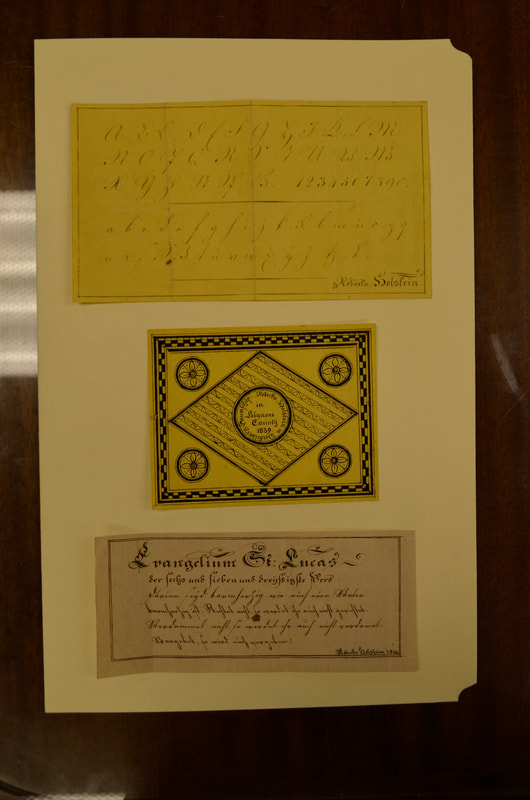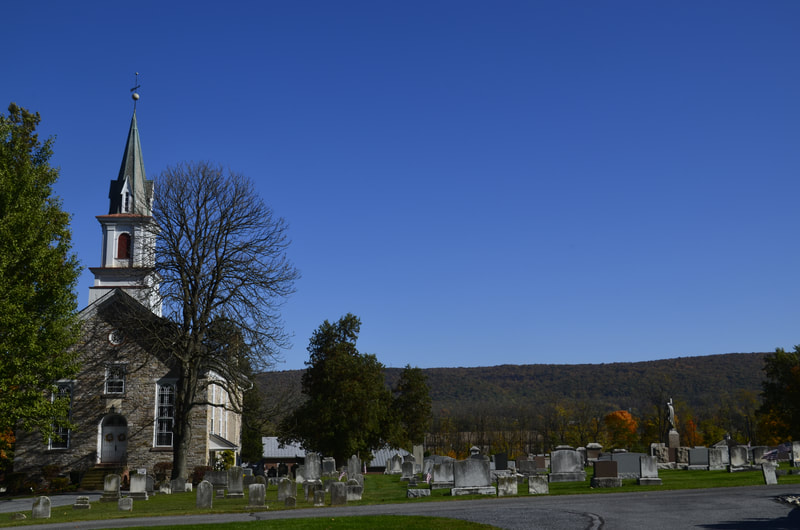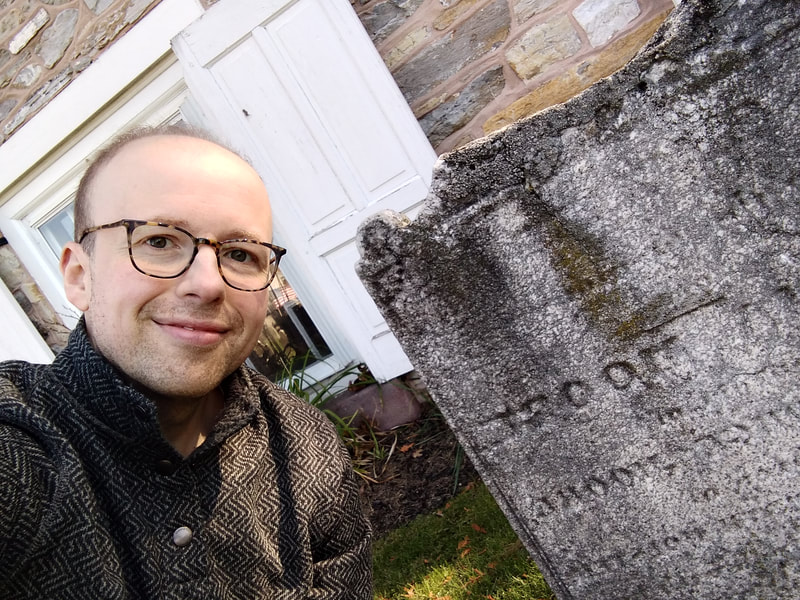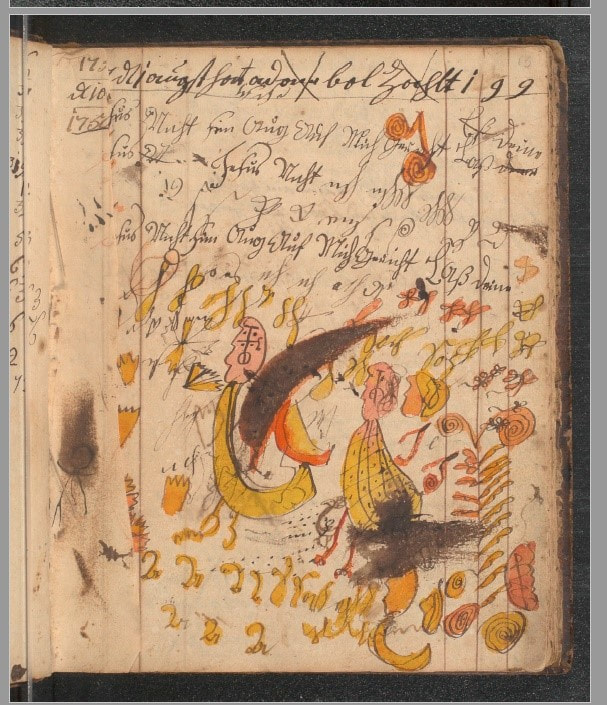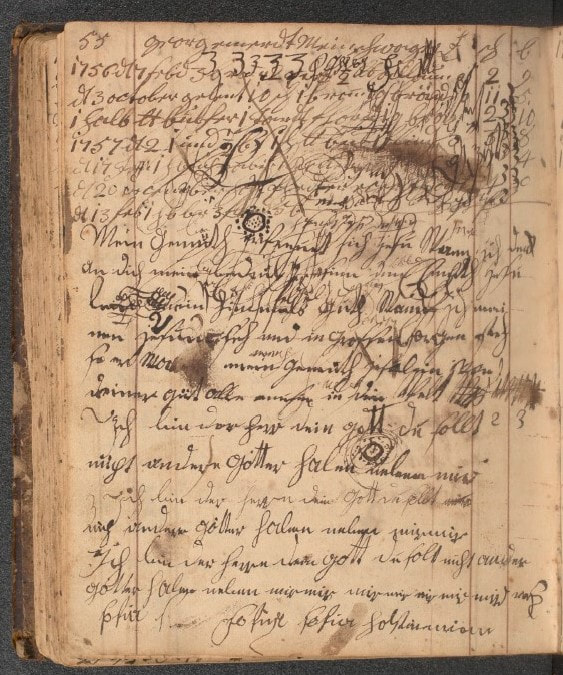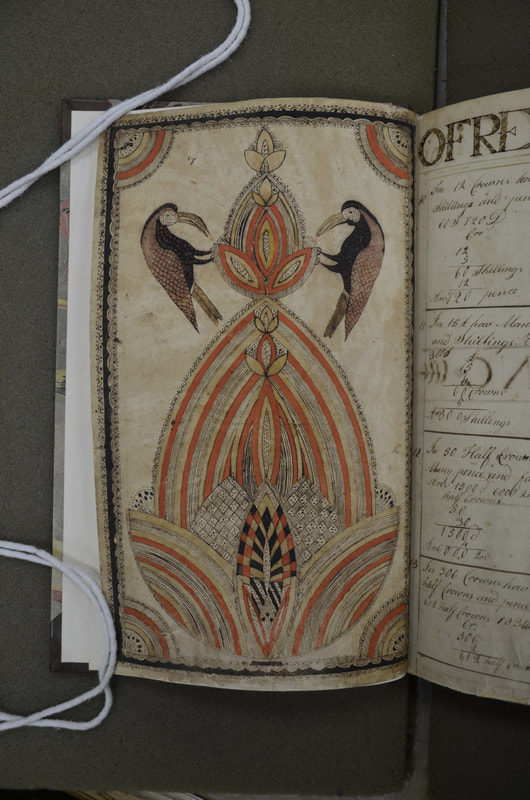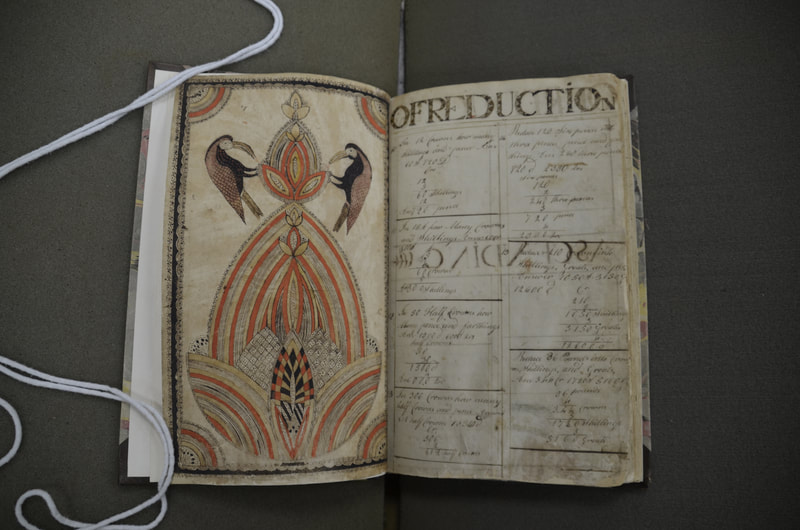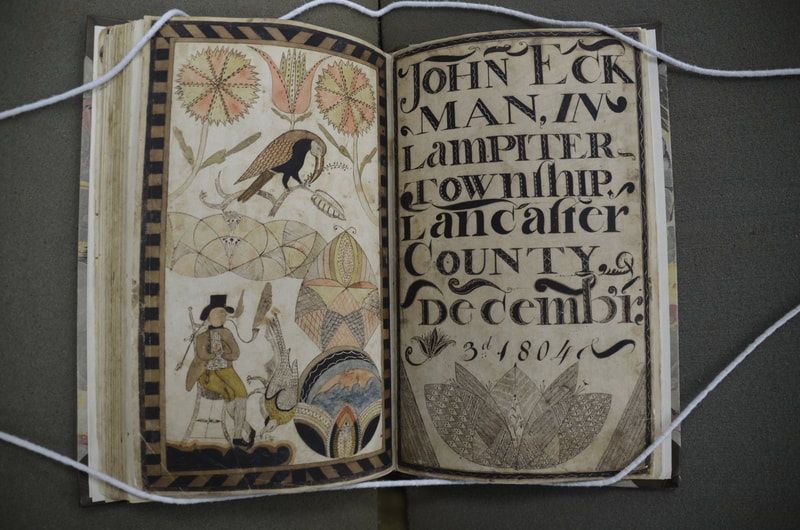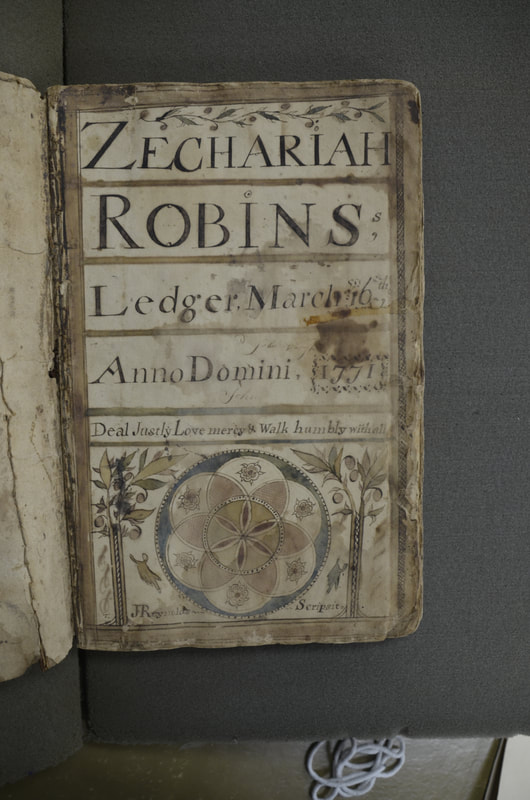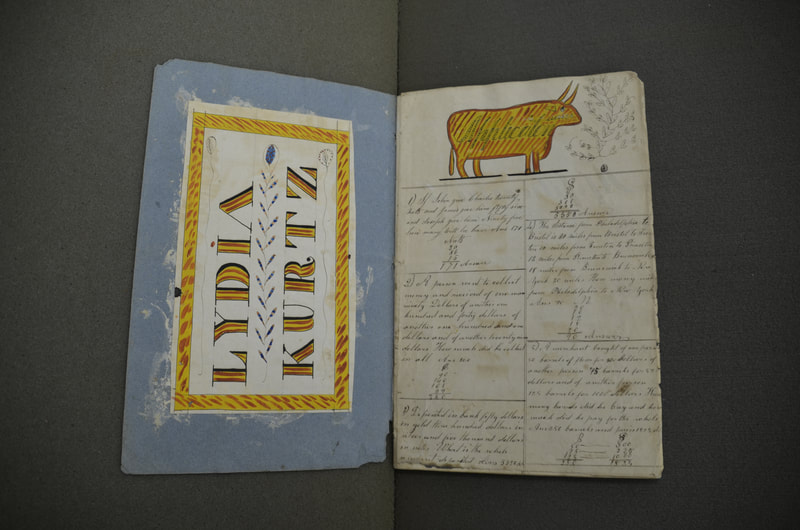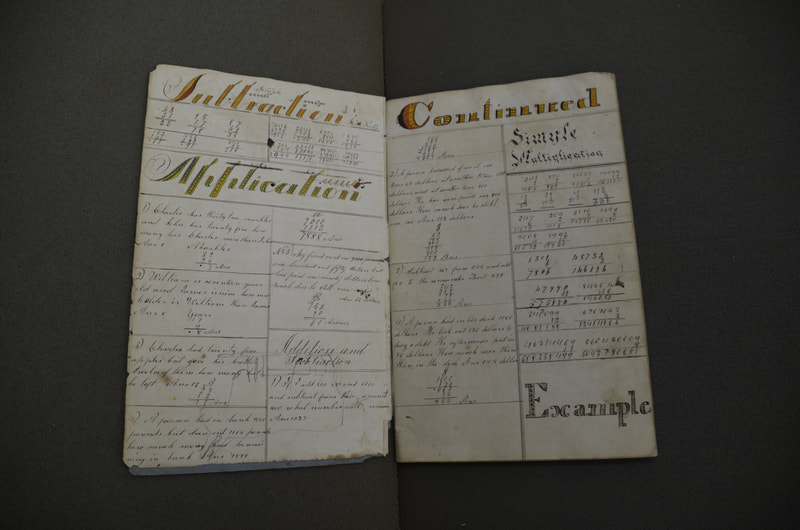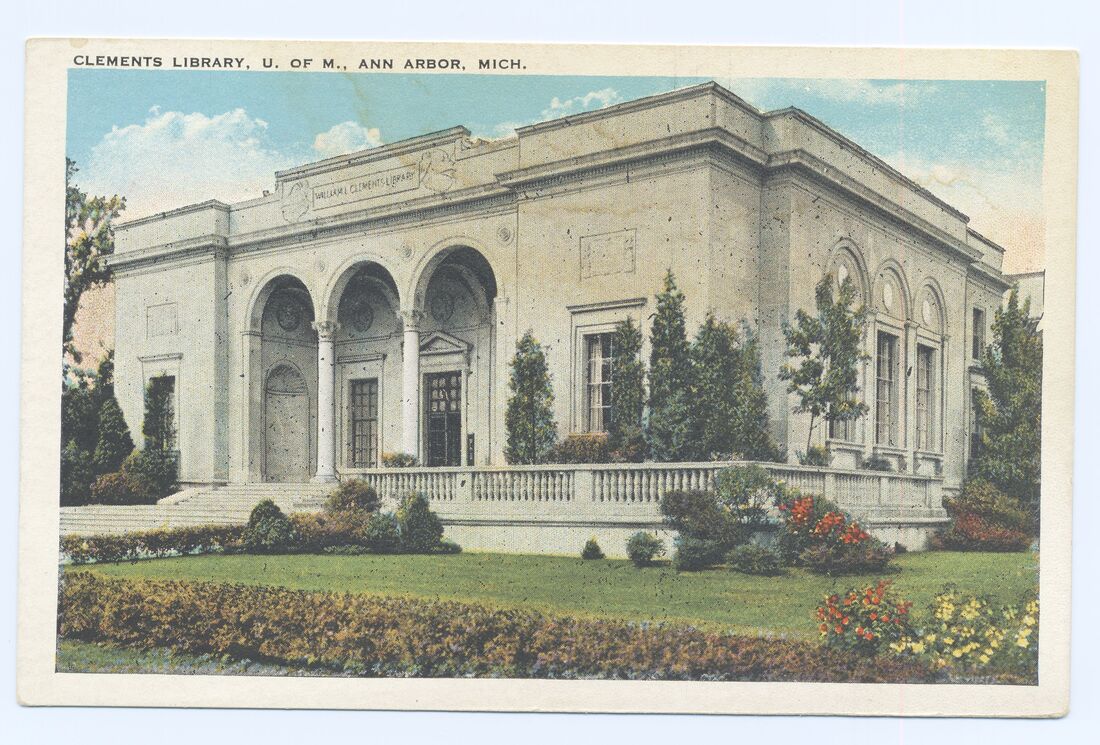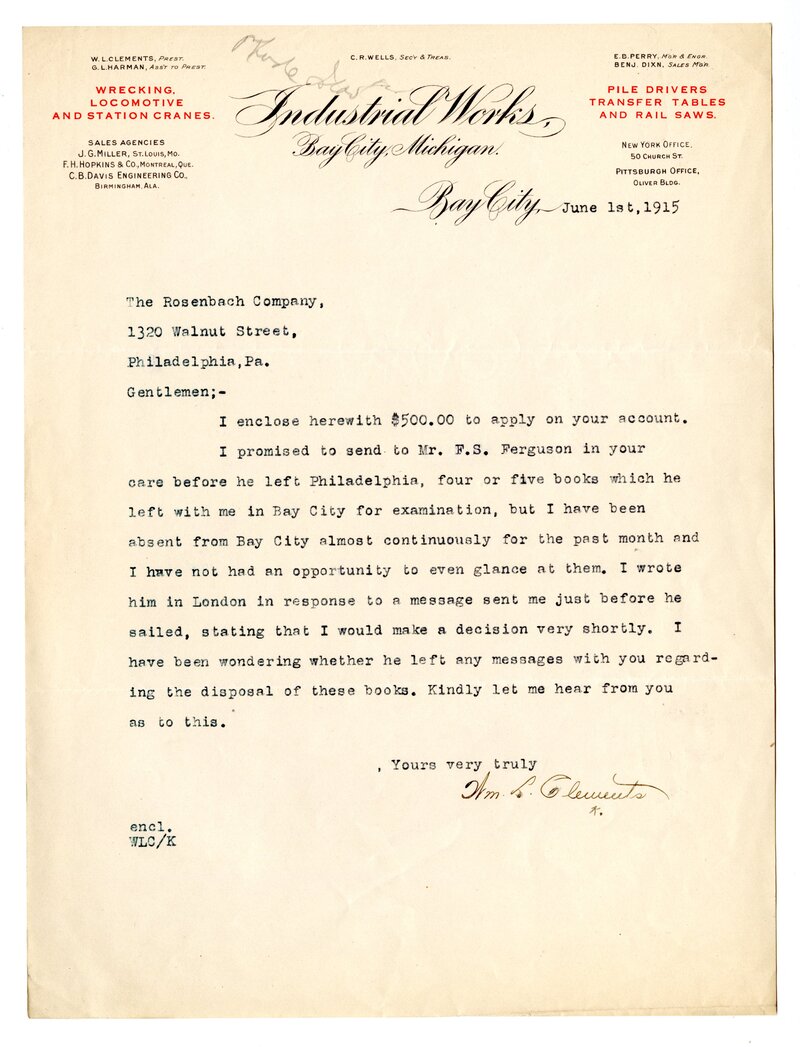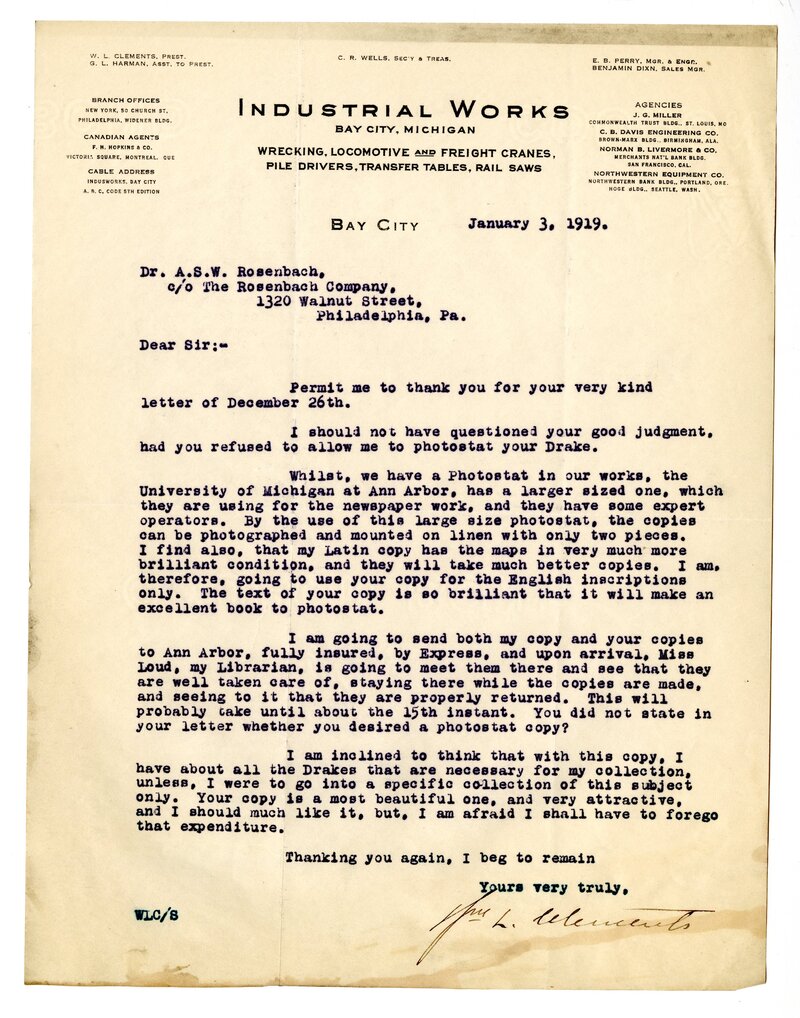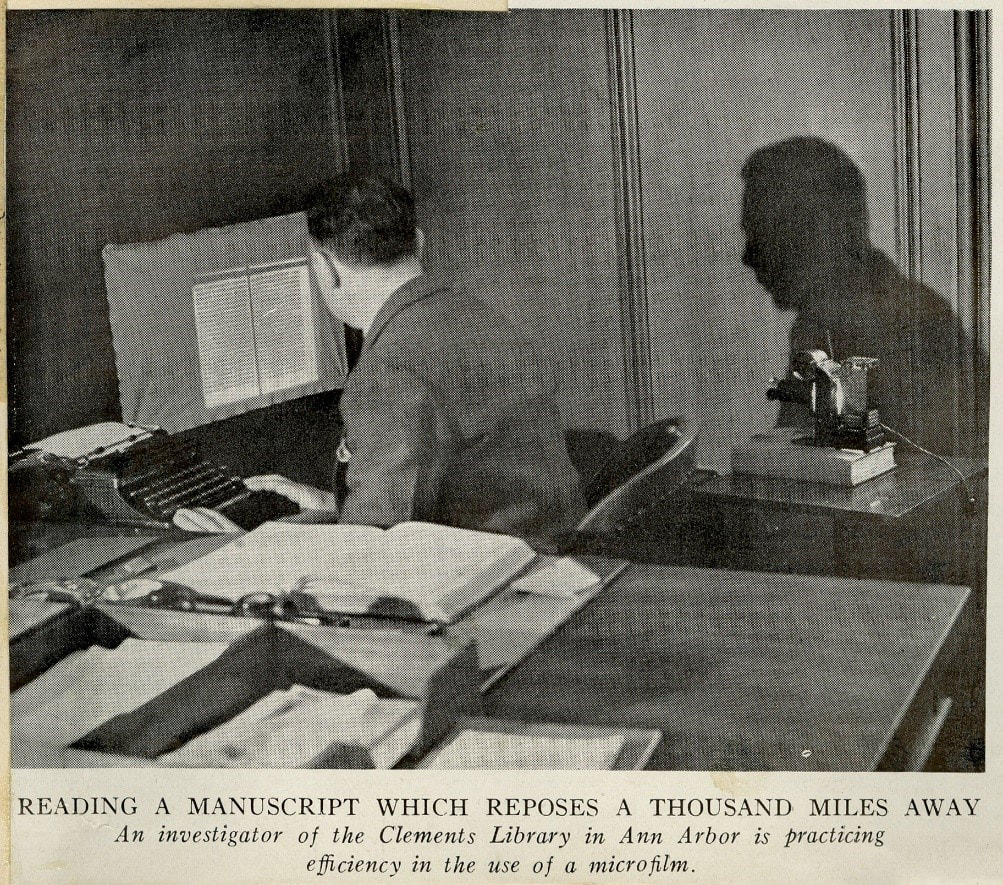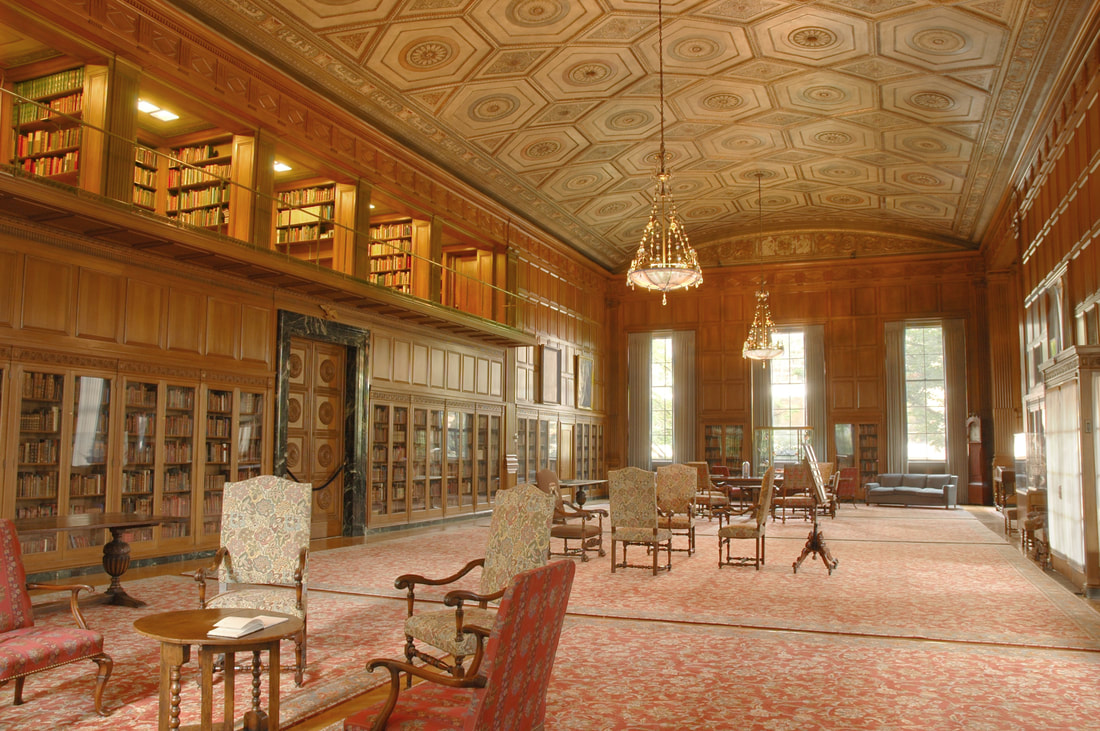Following up on key themes in The Word in the Wilderness, this new podcast welcomes you into the world of manuscript production, popular piety, and spiritual culture in early German Pennsylvania and beyond.
Episode 1: The History of Studying Pennsylvania Germans and Their Illuminated Manuscripts
This episode introduces listeners to trends in the study of Pennsylvania German illuminated manuscripts, commonly called "Fraktur."
Episode 2: What is "Fraktur"? Type, Script, and Art
This episode explores the many meanings of the word "Fraktur" in its European and American contexts and considers how best to deploy the term when discussing the manuscript art of the Pennsylvania Germans.
Episode 3: Who Were the Pennsylvania Germans, and Why do They Matter?
Pennsylvania German religious, spiritual, and cultural traditions were extremely complex. This episode offers a quick primer on many of the various German-speaking groups that resided in early Pennsylvania and explores their connection to the devotional manuscript arts.
Episode 4: What is "Manuscript Culture"? Reframing Pennsylvania German Manuscript Studies as a Sub-field of Book History
The study of Pennsylvania German illuminated manuscripts has long lacked a coherent theoretical and methodological foundation that situates the enterprise into wider scholarly conversations about religion, language, text, and culture. This episode proposes new approaches to unlocking the meaning of Pennsylvania German manuscripts, grounded in recent advancements in study of the history of texts as material artifacts.
Episode 5: Manuscript Culture Beyond Pennsylvania: Traditions in Asia, the Islamic World, Early Modern Europe, Great Britain, and the Americas
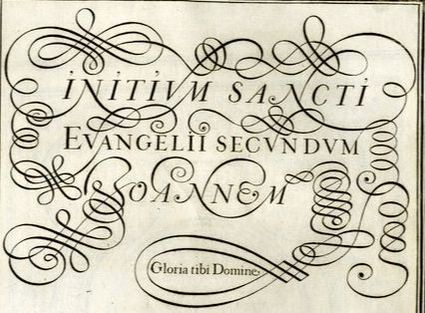
Ioseph de Casanova, Primera Parte del Arte de Escrivir Todas Formas de Letras. Escrito, y Tallado por el Maestro Ioseph de Casanova, Notario Apostolico, y Examinador de los Maestros del dicho Arte en la villa de Madrid, Corte de su Maestad, y natural de la villa de Magallon, Arçobispando de Zaragoça. Madrid: Diego Diaz de la Carrera, 1650, page 54. 11 3/4" H x 8 1/4" W. Z 43 C33 cep 3. Courtesy of the Hispanic Society of America, New York, NY.
Think that the Pennsylvania Germans were alone in their embrace of calligraphy and manuscript illumination as part of their spiritual enterprise? Think again. In this episode, learn about other cultures and communities around the world that employed the manuscript arts as culturally-resonant components of their popular piety long after the so-called "Age of Print" was well underway.
Episode 6: "The Root of Wisdom is to Fear the Lord": Wisdom Literature and Pennsylvania German
Manuscript Culture
Old Testament wisdom literature looms large over the Pennsylvania German manuscript arts. Learn about the historical significance of the wisdom literature as part of Pennsylvania German popular piety, and why the wisdom books provided such rich source material for scribes.
Episode 7: "Eines Christen Reise": Origins of The Word in the Wilderness
In this final episode of the first season of Cloister Talk, learn about the research and writing process that led to the publication of The Word in the Wilderness: Popular Piety and the Manuscript Arts in Early Pennsylvania.
Cloister Talk Season Two Teaser Trailer!
Season Two of Cloister Talk: The Pennsylvania German Material Texts Podcast debuts on Monday, January 4, 2021. In this trailer, learn about what questions and topics will be explored in the upcoming season, and about what primary sources you can expect to learn in the new episodes.
Episode 8: The Pirate Bible: An Epic Tale of Looted Germantown Bibles, and What It Reveals About Pennsylvania German Religion in a Vast Atlantic World
Pennsylvania German religious culture existed within a vast, complex, fluid, and interconnected world of German-Protestant spirituality and text exchange. Perhaps no artifact better exemplifies this heritage than a Pennsylvania-printed Bible held at the Free Library of Philadelphia that was once captured by pirates on its voyage to Europe! Listen to this remarkable story—and learn what it has to teach us about early American religion and history of the book.
Episode 9: Manuscripts in Focus: Penmanship Samples
Pennsylvania German manuscript penmanship samples are some of the most engaging, text-rich, and religiously-significant devotional documents created during the Long Era of Manuscripts in early Pennsylvania. This episode offers an in-depth introduction to the manuscript genre.
Episode 10: Manuscripts in Focus: Tune Books
Music has always figured prominently in Pennsylvania German religious culture, making it unsurprising that the musical and calligraphic arts intersected in potent ways during the Long Era of Manuscripts. In this episode of Cloister Talk, take a journey into the rich musical heritage of German Protestantism and its expressions in southeastern Pennsylvania.
Episode 11: Manuscripts in Focus: Birth and Baptismal Certificates
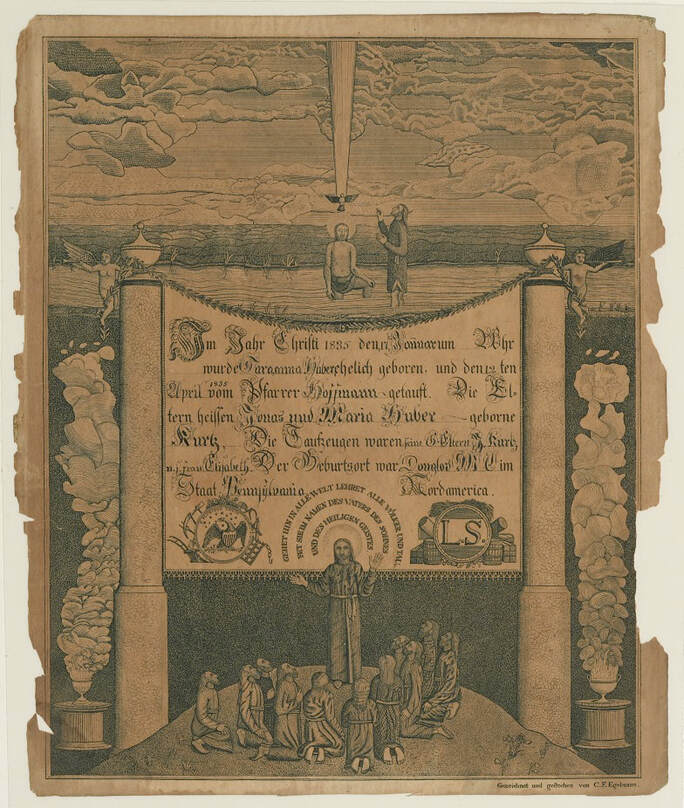
Carl Friedrich Egelmann, Geburts und Taufschein (birth and baptismal certificate) of Sara Anna Huber, Reading, Berks County, Pennsylvania, and Douglass Township, Montgomery County, Pennsylvania, 1835-1840. Ink and paper. 11 15/16” H x 9 11/16” W. 1980.0048. Museum purchase. Courtesy of Winterthur Museum.
Religious rituals and the commemoration of life events found rich expression in Pennsylvania German print and manuscript culture, especially on documents known as birth and baptism certificates. This episode of Cloister Talk offers a detailed analysis of the certificate genre and considers how it connects to other Pennsylvania German material texts.
Episode 12: Johann Gottfried Weber and Johannes Bard: Two Characters in the 18th-century Transatlantic World of Manuscripts
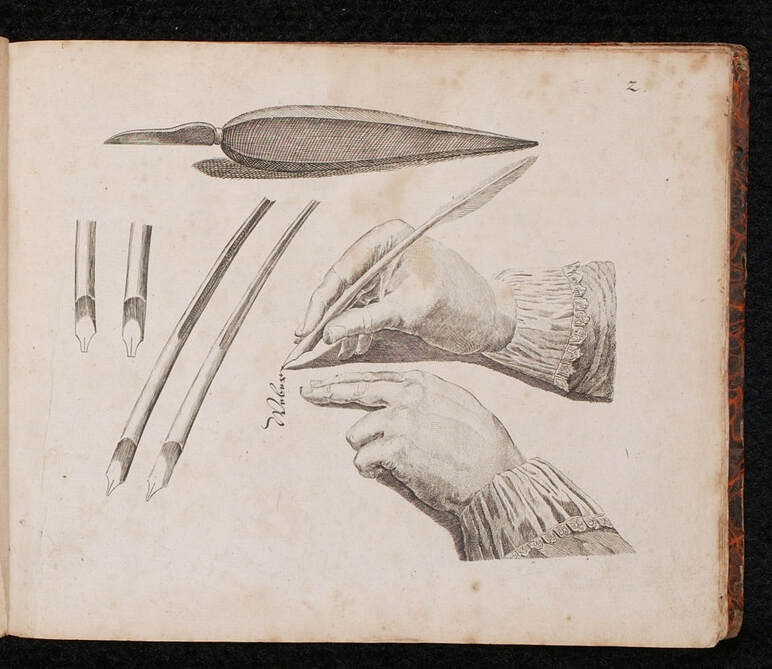
Johann Gottfried Weber, image of calligrapher’s hands at work, Allgemeine Anweisung der neuesten Schönschreibkunst des Hochgräflich Lippischen Bottenmeisters und Aktuarius (Duisburg am Rhein: Helwingschen Universitäts Buchhandlung, 1780), pl. 2. (Arca Artium Collection, Hill Museum and Manuscript Library, St. John’s University, Collegeville, Minnesota.)
Pennsylvania Germans figured prominently in a transatlantic world of copying and exchanging artistic, devotional texts. This episode of Cloister Talk examines intricate and remarkable artifacts of this culture of copying, drawing on resources from the Hill Museum & Manuscript Library at St. John’s University in Collegeville, Minnesota, and the Winterthur Museum, Garden & Library in Winterthur, Delaware.
Episode 13: A Lesson in Early Modern Linguistic Theory with Johann Merken, and Its Implications for the Study of Material Texts
The history of material texts naturally intersects with the history of language—and linguistic theory. Drawing on fascinating artifacts held at the Hill Museum & Manuscript Library at St. John’s University in Collegeville, Minnesota, this episode of Cloister Talk offers useful transatlantic intellectual-historical context for the place of German language (spoken, written, and printed) in the early-modern European world.
Episode 14: The Pennsylvania Pilgrim: Fireside Poet John Greenleaf Whittier's Interpretation of the Pennsylvania German, Quaker, and Early Abolitionist Francis Daniel Pastorius
The famous Quaker Fireside Poet John Greenleaf Whittier had a special passion for Pennsylvania history, which he expressed in his famous poem “The Pennsylvania Pilgrim.” Learn about Whittier’s interest in Pennsylvania religious heritage, his interpretation of the famous Pennsylvania settler Francis Daniel Pastorius, and what Whittier’s nineteenth-century poem reveals about collective memory of the United States.
Episode 15: "Errand Into the Wilderness": What Pennsylvania German Illuminated Manuscripts Mean in American History
A key topic addressed in The Word in the Wilderness: Popular Piety and the Manuscript Arts in Early Pennsylvania is how a deeper understanding of the spiritual underpinnings of the Pennsylvania German manuscript arts can add nuance to our interpretation of early American religious and cultural life. This episode of Cloister Talk explores that issue in greater depth, using Samuel Pennypacker’s book Pennsylvania in American History and intellectual historian Perry Miller’s famous work Errand Into the Wilderness as case studies for our analysis.
Episode 16: Afternoon Tea with Alexander Lawrence Ames: Answering Your Questions about Writing The Word in the Wilderness, and a Life Spent in Libraries and Museums
Writing The Word in the Wilderness: Popular Piety and the Manuscript Arts in Early Pennsylvania, especially sharing the book’s ideas with audiences from across Pennsylvania and around the world, has truly been a journey undertaken in community. At the conclusion of Season 2 of Cloister Talk: The Pennsylvania German Material Texts Podcast, it’s time to sit back, relax, and reflect on the book, the primary sources that made its analysis possible, and what The Word in the Wilderness and Pennsylvania German illuminated manuscripts have to teach us today. Make a hot cup of tea and settle in for a fascinating discussion! This final installment of Season 2 features personal reflections on the process of writing the book, and the fascinating world of historical museums and special collections libraries.
Cloister Talk Season 3 Teaser Trailer
Listen to the Cloister Talk Season 3 teaser trailer to learn what themes, topics, and discussions lie ahead later this spring and summer!
Episode 17: Cloister Talk Live! The Faith That Binds: A Conversation on Anabaptist Bookbindings with Chela Metzger and Erin Hammeke
How can material artifacts be wielded as tools for unlocking the lived experiences of past spiritual-devotional cultures? In this inaugural episode of Cloister Talk Live!, join book conservators Chela Metzger (University of California Los Angeles Library) and Erin Hammeke (Duke University Library) for a conversation about Swiss-Anabaptist bookbindings in early Pennsylvania—and what the books reveal about past personal and social relationships with God. The interviewees also discuss the state of book history as an interdisciplinary enterprise and offer advice for what it might take to bring historians, material culture scholars, and conservators together, to make optimal use of interdisciplinary expertise in analyzing and interpreting material texts.
Episode 18: Cloister Talk Live! Volksbibliothek: A Conversation with Dr. Maria Sturm and Bettina Hess of the German Society of Pennsylvania Library
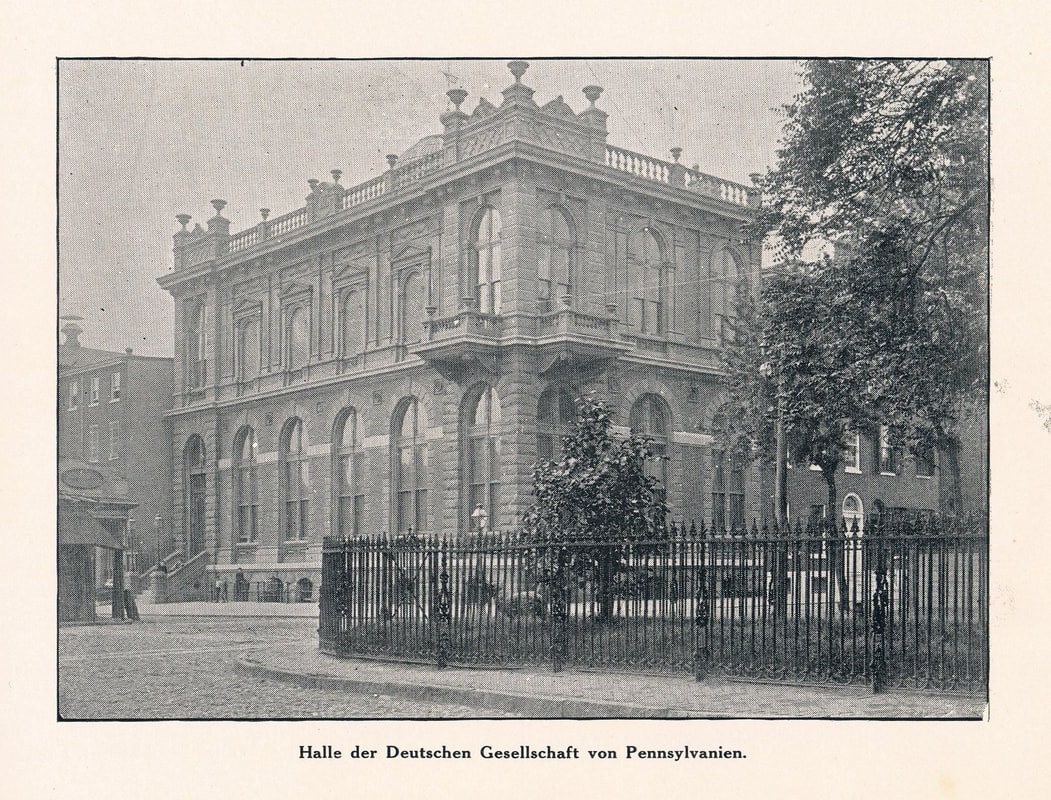
Image of the exterior of the German Society of Pennsylvania at 611 Spring Garden Street in Philadelphia, Pennsylvania, ca. 1907. 25. Stiftungsfest des Badischer Unterstutzungs-Verein abgehalten am Mittwoch, den 24. Juli 1907 auf Genengers Washington Park (AE 3000.1). Courtesy of the Horner Memorial Library, German Society of Pennsylvania.
Few library spaces glimmer with the sense of historicity and culture that the Horner Memorial Library at the German Society of Pennsylvania exudes. In this episode of Cloister Talk Live!, join historian and former German Society of Pennsylvania Library Committee Chair Dr. Maria Sturm, along with Society Librarian Bettina Hess, for an introduction to the historic library, its collections, and its work to make German-American history and culture accessible to all. Sturm and Hess highlight some of the fascinating holdings of the Library and reflect on the significance of the Library to understanding Philadelphia’s ethnic heritage.
Episode 19: Cloister Talk Live! Exploring the Free Library of Philadelphia Rare Book Department, one of the Great Collections of Pennsylvania German Text Culture, with Janine Pollock and Caitlin Goodman
The Parkway Central Library of the Free Library of Philadelphia is a majestic urban monument to literacy, learning, and robust civic discourse. What is more, the Rare Book Department at the Free Library ranks as one of the nation’s most important repositories of rare books, manuscripts, and other treasures of the history of human civilization. Its vast Pennsylvania German collection supported the interpretive work undertaken in The Word in the Wilderness. In this Cloister Talk Live! episode, librarians Janine Pollock and Caitlin Goodman welcome us into the world of the Rare Book Department and reflect on the significance of stewarding special collections in a public library environment.
Episode 20: Cloister Talk Live! At The Rosenbach: The Other Pennsylvania Germans? A Discussion of Early Southeastern Pennsylvania’s Jewish Community with Judith M. Guston
The multicultural life of early Pennsylvania included a vibrant Jewish community. Judith M. Guston, Curator & Director of Collections at The Rosenbach, discusses early Jewish settlement of the colony and the remarkable Gratz family holdings at The Rosenbach today, which document that early heritage. Ms. Guston also comments on the theoretical and methodological challenges of adopting a material culture approach to the study of past religious and spiritual life, and the meaning of early Pennsylvania’s religious plurality for American society today.
Episode 21: Cloister Talk Live! From The Rosenbach’s West Library: Religion and Early American Material Texts, from Cambridge, Massachusetts to Mexico City
Rare books at The Rosenbach showcase the incredible religious diversity throughout the Americas in the seventeenth, eighteenth, and nineteenth centuries. This episode of Cloister Talk brings us to the atmospheric West Library at The Rosenbach, to examine a few material texts that witness this early history, including The Rosenbach’s iconic copy of the Bay Psalm Book as well as its remarkable Doctrina breve, printed in Mexico City.
Episode 22: Cloister Talk Live! Books Along the Brandywine: A Conversation with Emily Guthrie, Formerly of The Winterthur Library
Nestled amid the rolling hills and verdant landscape of the Brandywine River Valley in Delaware, The Winterthur Library brims with rare books and manuscripts documenting material life in America, including early German Pennsylvania. Join Emily Guthrie, who until recently served as Director and NEH Librarian at The Winterthur Library, for a conversation about this remarkable repository of American history and culture, and how the Winterthur Library fits into the work of the Winterthur Museum and its surrounding 1,000-acre country estate. Ms. Guthrie, who recently took over as Librarian at the Library Company of Philadelphia, introduces us to the rich collections of Pennsylvania German rare books and manuscripts that reside in The Winterthur Library and tells us about her old side-gig as a shepherd and goatherd on the Winterthur estate. Well-known as one of the most prominent cultural institutions specializing in American history, the Winterthur Museum, Garden, & Library comes to life in dynamic new ways in this special episode of Cloister Talk Live!
Episode 23: Cloister Talk Live! Incense Hill: A Conversation with Kerry Mohn and Michael Showalter of Historic Ephrata Cloister
Few landmarks of early Pennsylvania heritage inspire awe and capture the imagination quite like Historic Ephrata Cloister in Lancaster County—a place of architectural beauty, spiritual devotion, mystical exploration, musical accomplishment, and tremendous historical significance to early-American book production and the manuscript arts. Ephrata Curator Kerry Mohn and Museum Educator Michael Showalter guide us through the history and significance of Ephrata and help us place the site within the wider context of early American religion and material culture.
Episode 24: Cloister Talk Live! A Mystical Heritage: A Conversation with Allen Viehmeyer and Candace Perry of the Schwenkfelder Library & Heritage Center
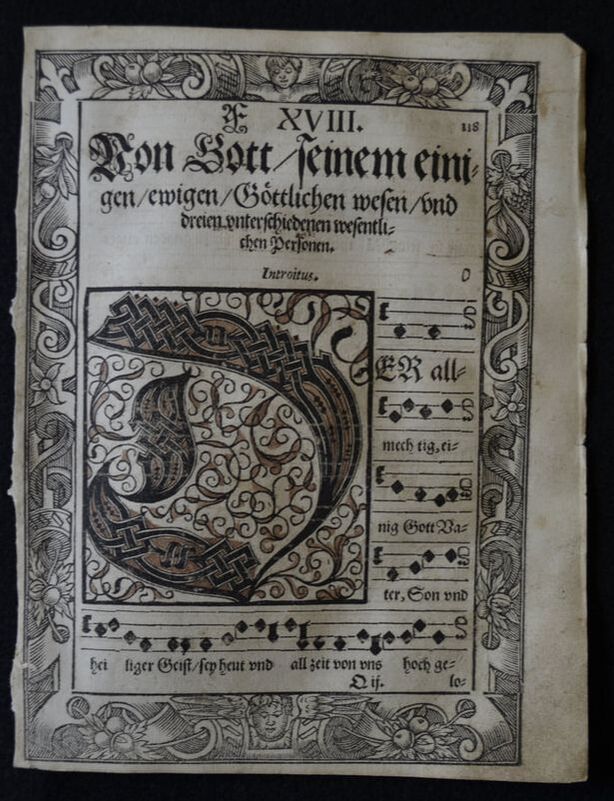
Das erste Teil der geistlichen Gesenge /von den wercken Jhesu Christi: und erstlich Von seiner gnad-reichen zukunfft und heiligen Menschwerdung. 1566. This volume has a Schwenkfelder provenance, having been inscribed by Maria Hübner in 1794. VR12-8 / L2004.0999.311. Courtesy of the Schwenkfelder Library & Heritage Center, Pennsburg, Pennsylvania.
Mysticism is a central (if complex, debated, and often misconstrued) part of the religious DNA of early German Pennsylvania. The theology and devotional practice of the Schwenkfelders—a German-speaking sectarian group present in the colony—connected to early modern European mystical tradition in important ways, and the religious community practiced a rich manuscript tradition. This episode of Cloister Talk Live! takes us to the Schwenkfelder Library & Heritage Center to dive into the Library’s astounding rare book, manuscript, and decorative-art collections. Curators and scholars Candace Perry and Allen Viehmeyer introduce us to the institution’s holdings, consider how they relate to the material culture of other Pennsylvania German groups, summarize the state of Schwenkfelder studies today, and suggest new directions for the field.
Episode 25: Cloister Talk Live! Dr. Franklin’s Library: A Conversation with James N. Green, Librarian Emeritus of the Library Company of Philadelphia
Founded by Benjamin Franklin, the Library Company of Philadelphia is the thriving epicenter of early American book history, and the inspiration of librarianship in America. James N. Green, Librarian Emeritus of the Library Company and a scholar of early American book history, introduces us to the history of the Library Company, the contours of its Pennsylvania German collections, and possible futures for the fields of material texts, Pennsylvania German studies, and cultural heritage preservation broadly conceived. Sharing personal memories of his long and distinguished career in librarianship and the history of material texts, Green also reflects on the unique library ecosystem that defines the Philadelphia region, the foundation of the Philadelphia Area Consortium of Special Collections Libraries (PACSCL), and the evolving civic role of libraries.
Episode 26: A Second Cup of Afternoon Tea with Alexander Lawrence Ames: Answering Questions about The Word in the Wilderness, and Some Closing Reflections on the Book
At the close of Season 3 of Cloister Talk, sit back and relax with a hot cup of tea to reflect on Pennsylvania German manuscript culture and popular piety in early America, and future directions for the study of early American cultural and intellectual history. Reader and listener-submitted questions considered in this episode include the implications of The Word in the Wilderness for our understanding of the changing place of cursive handwriting instruction in American schools today, shifting approaches to the scholarly study of Pennsylvania German calligraphy and manuscript illumination advocated in The Word in the Wilderness, and possible reasons for the long decline of traditional illuminated manuscript culture in German Pennsylvania. The episode closes with some personal reflections on next steps forward for the field of Pennsylvania German material texts within the context of closely-aligned scholarly disciplines. Make a hot cup of tea, get cozy, and settle in for an enjoyable conversation as the paperback version of The Word in the Wilderness makes its debut!
Cloister Talk theme music for seasons 1 - 3 is an adaptation of Anabaptist leader Menno Simons's famous hymn "We Are People of God's Peace," arranged and performed by the podcaster on harp and recorded specifically for Cloister Talk. Standard episode sound effects were graciously provided by BBC Sound Effects, http://bbcsfx.acropolis.org.uk/, © 2020 BBC.
Episode 27: Pennsylvania German Studies: Assessing the State of the Field with Patrick J. Donmoyer, Director of the Pennsylvania German Cultural Heritage Center at Kutztown University of Pennsylvania, and Author of Powwowing in Pennsylvania: Braucherei & the Ritual of Everyday Life.
Season 4 of Cloister Talk is devoted to the consideration of the past, present, and future of Pennsylvania German Studies. In this inaugural episode of the new season, Patrick J. Donmoyer of the Pennsylvania German Cultural Heritage Center at Kutztown University of Pennsylvania offers a broad-ranging assessment of the state of the interdisciplinary set of fields that comprise Pennsylvania German Studies. In this fulsome conversation, we discuss the historical origins of Pennsylvania German Studies in their current form, the most vibrant modern-day research areas, and Donmoyer’s recommendations for new pathways in the field. We also dive into Donmoyer’s own groundbreaking research in to the Pennsylvania German folk healing practices known as “Braucherei.” This episode of Cloister Talk will be an invaluable resource for those already deeply familiar with Pennsylvania German scholarship, as well as those just getting their start in the interdisciplinary field who are looking for new avenues available for groundbreaking study. Tune in today for an engaging introduction to the state of the field!
Learn more about the Pennsylvania German Cultural Heritage Center at Kutztown University by visiting https://www.kutztown.edu/about-ku/administrative-offices/pennsylvania-german-cultural-heritage-center.html. View a selection of Pennsylvania German material texts in the Heritage Center’s collection here: https://www.pagerman.org/of-the-image-and-the-word/. Below is a gallery of images from the Pennsylvania German Cultural Heritage Center: its facilities, its collection, its exhibitions, and its people.
Episode 28: Religious Landscapes in Early America: A Conversation About Johannes Kelpius with Dr. Timothy Grieve-Carlson
There are few characters from early Pennsylvania history more mysterious and fascinating than Johannes Kelpius, “the hermit of the Wissahickon” whose intellectual and spiritual life is the stuff of legend, centuries after his death. Kelpius embodied many of the deep traditions of European religious devotional life that found expression in early Pennsylvania—Pietism and mysticism included. In this episode of Cloister Talk, Dr. Timothy Grieve-Carlson welcomes us into the world of Kelpius’s spirituality as it connects to early modern understandings of nature and the environment and discusses Kelpius’s lasting resonance as a religious pioneer of sorts. Professor Grieve-Carlson also walks us through his research process and reflects on future pathways in Pennsylvania German studies.
Episode 29: Studying Pennsylvania German Manuscript Culture in Lancaster, Pennsylvania, an Early-American Cultural Crossroads. Results of a Week of Research at LancasterHistory.
Lancaster, Pennsylvania has been a diverse cultural crossroads for centuries, and the immense collections of LancasterHistory document the history of calligraphy, penmanship, and literacy education in this important urban center of Pennsylvania German life. In this episode of Cloister Talk, we’ll explore the penmanship and calligraphy collections at LancasterHistory to reflect on how they can inform our interpretations of rural Pennsylvania German “fraktur” manuscripts. The episode also includes a discussion of research methodologies and a consideration of scholarly trends in the interpretation of Pennsylvania German manuscript culture.
Learn more about LancasterHistory at https://www.lancasterhistory.org/.
View photographs of the Ludwig Denig emblem book at the Winterthur Museum, Garden, & Library here.
Episode 30: Pennsylvania German Studies as an Interdisciplinary Enterprise: A Conversation About Musicology, Performance, and the Scholarly Life with Dr. Christopher Dylan Herbert.
One of the most wonderful things about Pennsylvania German studies is the opportunity they open for interdisciplinary research. In fact, interdisciplinary perspectives that draw on multiple theories, methodological approaches, and research skill sets are required to develop a fulsome view of Pennsylvania German culture. In this episode of Cloister Talk, musicologist Dr. Christopher Dylan Herbert grants us special insights into his research focused on the music of the Ephrata community. We consider Dr. Herbert’s inspirations for exploring Ephrata’s rich and complex musical heritage, the findings of his research, and the value of interdisciplinary methods in a shifting scholarly landscape. Listen to Dr. Herbert’s new album of Ephrata music, Voices in the Wilderness, here: https://open.spotify.com/album/6iPkwxZsUaOEbY2zeB4gf0.
Note: This interview was recorded live and in-person. Occasionally, the host’s questions and comments were not picked up by the mic, but the interview guest’s responses are all clear.
Episode 31: Pennsylvania Germans and Other Early American Ethnic, Racial, Linguistic, and Cultural Communities: A Conversation with Dr. Leroy Hopkins.
If any single theme or idea emerges from consideration of the history of Lancaster County, it is the possibilities, and perils, of intense ethnic, racial, linguistic, and cultural interaction. From the earliest settlement of the area by European settler-colonizers all the way through to the present day, Lancaster County is a remarkably multifaceted community. Reflective of broader trends in America history, the cultural mixing that occurred in the region resulted in horrifying violence and remarkable displays of the pluralism that in many ways is distinctive of the American experience. The guest on this episode of the podcast, Dr. Leroy Hopkins, has devoted his scholarly career to investigating the interactions of Pennsylvania Germans and Black residents of the county, and what the presence of both of these communities in Pennsylvania can teach us about race, ethnicity, language, and culture in America. A native of Lancaster, Dr. Hopkins received a B.A. in German and Russian from Millersville State College in 1966 and a Ph.D. in Germanic Languages & Literatures from Harvard University in 1974. Dr. Hopkins served as Associate Director of Program and Planning and then as Acting Executive Director of the Urban League of Lancaster County from 1976 to 1979. He then began his tenure at Millersville University in 1979, retiring in 2015 as Professor Emeritus of Foreign Languages. He’s done extensive international research to understand the connections between Germans and Black Americans. In this episode of Cloister Talk, we discuss Dr. Hopkins’s scholarly journey and his thoughts about promising pathways in Pennsylvania German studies.
Episode 32: Design History as Cultural History: A Conversation About Pennsylvania German Design with Historian and Artist Rachel E. Yoder.
One of the most wonderful things about Pennsylvania German Studies is its interdisciplinary nature, and its bringing together of scholarly study with artistic and craft practice. In this exciting episode of Cloister Talk, accomplished artist Rachel Yoder discusses the origins of her passion for Pennsylvania German/Pennsylvania Dutch design and how the visual arts connect her to a Pennsylvania Dutch family heritage. We discuss Rachel’s new book Pennsylvania Dutch Design: A History of Kitsch, Folk Art, & More, as well as how historical research informs Rachel’s work. This conversation will inspire you to pick up a quill and paintbrush and try your hand at Pennsylvania Dutch folk art traditions!
Learn more about Rachel’s artwork at https://www.rachelyoderart.net/.
Episode 33: The Holstein Family Account Book: Studying a Manuscript Artifact of Pennsylvania German Life at the William L. Clements Library of the University of Michigan.
Resources to study the history of Pennsylvania German material texts exist in institutions all around the nation and world, and it behooves scholars to look beyond the best-known repositories in southeastern Pennsylvania in order to discover underutilized and undiscovered resources. It also is in historians’ best interest to make use of examples of Pennsylvania German calligraphy and penmanship that may not rank as the most beautiful examples of the art form but push us to understand Frakturschrift calligraphy in a broader social-historical context. The Holstein family account and penmanship practice book at the William L. Clements Library of the University of Michigan offers a wonderful example of both of these points. Created by several generations of a rural Pennsylvania German family, this everyday manuscript provides insight into how children learned penmanship, manuscript illumination, and lessons in Protestant piety. In this special episode of Cloister Talk, we take a virtual trip to the Clements Library in Michigan to study the complex, fascinating, and analytically rich Holstein manuscript. The episode takes a deep dive into the materiality of the manuscript before considering the history of the Holstein family and drawing comparisons with other account books and penmanship exercise books held by the Winterthur Library in Delaware. The episode also includes reflections on lessons learned for Pennsylvania German studies.
You may view the Holstein manuscript here, via the Clements Library’s digital repository: https://quod.lib.umich.edu/h/holsteinfam/.
Episode 34: The William L. Clements Library: Exploring the University of Michigan’s Library of Early American History and Culture. A Roundtable Discussion with Clayton Lewis, Emiko Hastings, Cheney J. Schopieray, and Maggie Vanderford.
The William L. Clements Library at the University of Michigan is a world-renowned repository for the study of early American history—holding artifacts including the Pennsylvania German Holstein family’s account and penmanship exercise book discussed in the previous episode of Cloister Talk. In this special roundtable discussion, we’ll go behind the scenes into the work of the Clements Library to preserve treasures of American history with members of the Library’s distinguished staff. We also discuss the staff members’ favorite objects in the collection, and how they interact with University of Michigan students and the general public.
Episode 35: The Digital Revolution in Special Collections Access: Assessing the Present State and Future Prospects of Collections Digitization with Christopher Ridgway, Digitization Technician at the William L. Clements Library of the University of Michigan.
Rare book libraries, archives, and museums find themselves in the midst of a digitization revolution, which is shifting discoverability of, and access to, their collections, and bringing about a transformation in institutions’ conceptions of their place within the social world. These trends have become even more pronounced on the heels of the COVID-19 pandemic, which changed expectations for the special collections library user experience. In this episode of Cloister Talk, we’ll take a peek behind the curtain of digitization efforts at the William L. Clements Library at the University of Michigan, where technicians recently digitized the Holstein family account book for consideration in this season of the podcast. Chris Ridgway, Digitization Specialist at the Clements Library, shares details about digitization processes and workflows and offers insights on how digital technologies are shifting the work of special collections libraries. All collections-based scholars have a vested interest in the finances, operations, and strategies of institutional digitization projects, so check out this conversation for some valuable insights into one of the key trends shaping special collections libraries today.
Episode 36: The Place of Rare Book and Special Collections Libraries in the Research University: A Conversation with Dr. Paul J. Erickson, the Randolph G. Adams Director of the William L. Clements Library at the University of Michigan.
Special collections libraries and archives shape the work of historians and other researchers by preserving and making accessible the records of our shared past. Yet they are also complex, vibrant institutions immersed in the changing social, cultural, academic, and information landscape of the 21st century. What challenges and opportunities to special collections libraries face, especially in an era of rapidly evolving information technology? How do different kinds of libraries and archives—from those situated at major universities to small, independent operations—address these opportunities and challenges? In this special conversation with Dr. Paul J. Erickson, the Randolph G. Adams Director of the William L. Clements Library at the University of Michigan, we’ll dive into these and many more questions about the work of libraries and archives as they stake a claim in 21st-century America’s hotly contested civic space.
Learn more about the Clements Library at https://clements.umich.edu/.
The theme music for Cloister Talk Season 4: Pathways in Pennsylvania German studies is the Kyrie from the Mass in B Minor by Johann Sebastian Bach. The Bach Choir of Bethlehem, Pennsylvania gave the first performance of the Mass in America in 1900. The full recording of the Mass may be heard here.
